Review Article - (2017) Volume 25, Issue 1
Kufakwanguzvarova Wilbert Pomerai*
Faculty of Medicine, University of Zimbabwe, Zimbabwe
Corresponding Author:
Kufakwanguzvarova Wilbert Pomerai
Faculty of Medicine, University of Zimbabwe, Zimbabwe
Tel: +2634303211
E-mail: pomeraiwilbert1@gmail.com
Submitted date: December 26, 2016; Accepted date: February 23, 2017; Published date: March 02, 2017
This study sought to investigate the service quality expectations and perceptions for Ante Natal Care patients at Mberengwa District Hospital. This was, in the main a qualitative study in which the knowledge and practices of Ante Natal Care patients were sought so as to establish their opinions, beliefs and ideas towards the service quality at the Health Care facilities in Mberengwa District in the Midlands Province. It is from a target population of 110 subjects who are Ante Natal Care patients that a sample size of 100 was extracted. The response rate was a surprising 63.64%. The specific objectives which this study sought to ascertain were; to understand the customer expectations of service quality, to investigate the customer perceptions of service quality and to investigate the client satisfaction level of ANC patients at 39 rural Health Centres in Mberengwa. The main research instruments used in this study were the questionnaire. One questionnaire was constructed for the Ante Natal Care patients. The findings were as follows: that Ante Natal had high expectations of the service delivery by the Mberengwa District Hospital. Patients had high expectations of the service delivery right from the time they phoned to try to make an appointment, the time they got to the reception to receive service, the care they got from the Dr or Senior Nurse, the health facility working hours well, the waiting times in the queue, and whether if they would recommend the health care facility to fellow patients. As for the perceptions, after visiting the Health Care it was noted that their perceptions dropped the minute they visited the health care facility. Indeed they rated the reception they got to be poor, there was no appointment system, the working hours were odd, certainly not what the customer expected. Patients could not see a specific Dr. or senior if they wanted to, the waiting period before being attended by the Health Care Worker was rated very poor by the ANC patients, the Health Care worker did not give the patients to explain their situation. In the end the ANC patients rated the overall service that they got at their local health Care facility to be poor, if they had a choice they would definitely not visit that health care facility again, finally the majority of respondents clearly stated that they would never recommend their local health Care facility. The following recommendations were made, Mberengwa District health authorities should improve their staff training programmes in customer care, Secondly the Mberengwa health care facilities should have flexible and extended working hours, and also the staffing levels should be increased so that ANC patients do not wait indefinitely for service. The system should be arranged in such a way that a patient should be able to book their appointment in advance to see a Dr of their choice.
Antenatal care; Health; Patient
Background to the study
Luke argues that healthcare is one of the most important components in human life. Disease or illness can prevent a person from doing a host of activities one could have easily done when they were strong and healthy. They went on to say that Healthcare may be defined as “the management or treatment of any health problem through the services that might be offered by medical, nursing, dental or any other health related service provider”. The success of any health care service provider largely depends on the quality of service that is being accorded to the customer and the level of satisfaction that customers derive from any such health care delivery.
In a separate study a researcher adds on to report that customer satisfaction is indeed a key ingredient to the success of any service provider, it is the most important factor that creates loyal customers. Many healthcare facilities have downplayed the importance of customer care and this has negatively affected the image of such facilities. If customers are satisfied with goods or services an organization offers, chances are that they will patronise more of the service provider’s products, which will increase sales revenue and profitability. Accordingly, an improvement of service quality leads to customer satisfaction and loyalty as well as enhancement of corporate image. This, in the long run impacts on how well the organization can effectively compete and succeed in this increasingly competitive environment
Williams et al. argues that Patient satisfaction has emerged as an increasingly important health outcome [1]. Satisfaction is believed to be an attitudinal response to value judgments that patients make about their clinical encounter satisfaction is either implicitly or explicitly defined as an evaluation based on the fulfilment of expectations. Patient satisfaction regarding health care is a multidimensional concept that now becomes a very crucial health care outcome.
According to some researchers “a meta-analysis of satisfaction with medical care revealed the following aspects for patient satisfaction and overall performance of an organization: overall quality, trust, reputation, continuity, competence, information, organization, facilities, attention to psychosocial problems, humaneness and outcome of care.” All of these factors have high influence on service quality of health care organizations and at the same time can influence the satisfaction level.
Scientists maintain that health care system is now a challenge for every health care provider due to high competition in the field. The health care system that was dominated by non-profit/public hospitals is now provided increasingly by the private sector. This competition results in satisfying patient through improvement in service quality dimensions, building trust and getting positive reputation. Some questions have been raised whether achieving these valuable goals in health care organizations, need to be addressed. For example, who wants to improve health care service quality? Who is changing and innovating new techniques? Who is functionally and technically well sound? Whose organizational atmosphere is frankly and friendly? Is Feedback, communication, interaction and trust which is the most important factor incorporated in organization? The organizations which emphasize and respond to above questions lead the organization towards positive reputation in the society.
Need for promoting quality in health care
According to the World Health Organization (WHO) there are two main arguments for promoting a focus on quality in health systems at this time. Firstly, even where health systems are well developed and resourced, there is clear evidence that quality remains a serious concern, with expected outcomes not predictably achieved and with wide variations in standards of health-care delivery within and between health-care systems.
Secondly, where health systems, particularly in developing countries need to optimize resources use and expand population coverage, the process of improvement and scaling up needs to be based on sound local strategies for quality so that the best possible results are archived from new investment [2].
Several models of health care evaluation have been proposed and designed to measure the patient satisfaction and service quality dimensions. Perhaps the most popular model is design by a researcher, who took three factors/dimensions, i.e., structure, process and outcome to evaluate quality of care and patient satisfaction. The first factor deals with the structure of the organization and the condition under which the service is provided. Second factor elaborates the process that refers to the professional activities by the health care. The third factor is outcome and refers to the result or patient rating, which means the current and future difference of patient’s health and satisfaction level. Outcome is the most important factor to measure and to evaluate the patient satisfaction and service quality. The relationship among the structure, process and outcome should be very strong and clear because one can affect the other. In order to be satisfied, everybody is free to choose the best health care quality and service, but the question is: what happens to the rural poor where people cannot afford the expensive private health care providers? [3].
In measuring satisfaction with relation to service quality, most of the researchers use SERVQUAL model. For the very first time a researcher used five quality dimensions (5Qs) model, which is a combination of technical-functional and SERVQUAL quality model. The 5Q model of the service quality covers most of the factors regarding health care. 5Q model consist of quality of object, quality of processes, quality of infrastructure, quality of interaction and quality of atmosphere. The 5Q model is a strong tool to measure patient satisfaction regarding service quality.
Another factor that can lead a patient to satisfaction is trust. Trust is especially important in health care service organizations. Many definitions of trust have been proposed, however a core concept is that trust is the acceptance of a vulnerable situation in which the truster’s believes that the trustee will act in the truster’s best interests. Trust is the basic and fundamental aspect to measure, Health care professional attributes identified by patients as engendering trust may be grouped into domains of technical competency, interpersonal competency, and agency (also called fidelity, loyalty or fiduciary duty). Patient trust expresses a combination of variables; most important is the satisfaction and is more salient feature to measure the quality of on-going relationships. Measuring trust would help to inform public policy deliberations and balance market forces, which threaten the doctor-patient relationship. Trust is a very crucial factor which builds and establishes through continuous improvement in overall service quality dimension and organizational reputation [4].
Some of the scientists are of the opinion that Organizations with positive reputation support the argument that high quality of service firms will be larger and have more customers since fewer customers will depart from high quality firms in the long run and more will arrive because of word-of-mouth activity from other customers. Organizations with high reputation maintain long life and have more customer/patients due to high satisfaction level based on credibility, quality and service [5]. Strong relationship can be found between reputation and customer/patient satisfaction from practical as well as from theoretical point of view.
In the present healthcare environment customer care and satisfaction have become the prime concerns of each and every healthcare facility. In the contemporary time organizations are increasingly becoming customer focused. Satisfying the needs and wants of customers more efficiently and effectively enable them secure increase sales, sales revenue and profitability as well as corporate image.
The bottom line is when not satisfied; patients will eventually turn to other healthcare providers who will meet their needs. Poor customer care and satisfaction in this perspective are the leading indicators of future decline or growth of a healthcare facility. There is obviously a strong link between customer satisfaction and retention in the healthcare delivery system. That is why many organizations are attempting to obtain increased customer satisfaction by focusing on the quality of their products and deliveries to consumers and customers.
According to the Annual Report for Midlands Province 2013 Mberengwa District had the highest number of women who died while giving birth due to preventable and detectable condition if the women had done ANC. A total of five women died while giving birth in Mberengwa in 2013. Further there are a very high number of babies who die less than 28 days after birth. Furthermore the number of women who attended ANC is less than 50% against an expected percentage of 100%. The proportion of women who deliver in clinics and hospitals is also very low 48% against an expected percentage of 100%. This leads to many maternal deaths and neonatal deaths in the district [6].
The principal purpose of this study is to evaluate the service quality expectations and perceptions of Ante Natal Care Patients at Mberengwa District Hospital. This will be done through the following objectives:
Aims and objectives of the study
• To understand the characteristics of a service.
• To understand service quality in the context of its five dimensions.
• To investigate whether there are gaps between patient expectations and perceptions in in health care delivery.
• To come up with suggestions on quality improvement in ANC in Mberengwa district.
Research questions/sub-problems
This research postulates that there are weaknesses in the current service quality delivery system in Mberengwa’s and the following research questions will guide this study:-
What are the patient expectations during ANC?
How do patients perceive service quality in health services delivery?
Which gaps exist between patient expectations and perceptions in health care delivery?
How do patients perceive the gaps between expectations and perceptions in in health care delivery?
Policy makers in the ministry of health and child welfare
Increased still births and mortality rates are a concern to governments throughout the world; this study may help bring back to the hospitals those disgruntled mothers who were now utilizing unhygienic home based mid-wives for their deliveries. It was getting difficult for policy makers and planners to plan for a holistic health delivery system knowing very well there were some mothers who were avoiding health Care facilities in the area, this study may help centralized planning for sustainable development in the health service sector [7].
Non-governmental organisations in health care
The stake holder will benefit in knowing the gaps that exist and funding opportunities that they can take advantage of to improve service quality.
Academics and researchers
This study will bring about hypothesis that may need to be tested further. The information from this study will work as foundation for further studies in service quality in the health services sector.
Hospitals and clinics in Mberengwa
With increased hospital and clinic attendances these health Care service providers will generate more revenue which will help improve the generality of health standards in the Mberengwa District.
ANC customers
Poor service in hospitals and clinics in the public health care facilities have led to reduced attendances by pregnant mothers who desperately need Ante Natal Services at hospitals and Clinics. Therefore this may help Ante Natal care as this will help stem the tide against home based deliveries. As already said pregnant mothers were shunning standard WHO recommended based deliveries due to bad service quality at the hospitals and clinics [8].
Assumptions of the study
This study is founded on the following assumptions:
That the authority to conduct the research, granted at the start of the study is not going to be revoked at a later stage.
Further, the various levels of staff in the different sections of the health services sector are going to co-operate, with researcher by freely volunteering information and answering questions accurately, sincerely and objectively, with a seriousness of purpose and also provide the requisite documentation as and when required by the researcher, when the situation so demands [9].
It is assumed that the respondents are going to understand and appreciate the questions in the same mode and context that the researcher will have put them and not infer meaning and motives (to questions) other that those expressly sought by the researcher.
It is also assumed that the response rate on the questionnaire is going to be so significant that the researcher would obtain complete, accurate and relevant data and thus draw valuable conclusions while making sound recommendations to this research.
Some of the terms used in this study have specialized meanings which might not have the same meaning outside the context of this study. These terms are defined below:
Antenatal care
Medical services offered to pregnant women so as to improve their health and birth outcomes.
Customer
Someone who utilises the services of company.
Hospital
Institution for treatment of the sick and those who are unwell.
Affordability
Ability of client to pay for the services
This study will focus specifically at service quality expectations and perceptions of Ante Natal Care Patients Mberengwa District. Geographically the study will cover ANC services at Mberengwa District Hospital. The period covered will range from January 2013 to July 2014 [10].
Ideally it would have been preferable to carry out a research of this nature covering all hospitals and Clinics in the Midlands District however limited time and resources at the disposal of the researcher have forced him to limit the survey just six xx Hospitals and clinics in Mberengwa.
Time and money have always been scarce resources; the fact that the researcher will have to conduct the research on a part time basis will be a challenge that he will have to work hard to overcome. Indeed juggling between a demanding job and the dictates of an equally compelling family life, while conducting meticulous research that also requires attention to detail will not be an easy task. Also transport costs that will be incurred in the countless journeys to deliver, administer and collect the questionnaires, around the various Mberengwa Hospitals and clinics will be a limitation the researcher will have to endure and overcome [11].
Finally, to try and minimize on the negative impact of these and other limitations, the researcher shall emphasize to the respondents that their individual answers and views will be used for research purposes only and thus be kept as confidential information.
According to some scientists argue that “goods can be defined as objects, devices or things, whereas services can be defined as deeds, efforts or performances.” Services are dependent on the interaction between the client and service provider. This means that services are processes, not things and therefore a service firm has no product but only interactive processes. Some researchers offer a comprehensive definition of services where service is “an activity or series of activities of a more or less intangible nature than normal, but not necessarily, take place in the interaction between the customer and service employees and/or physical resources or goods and/or systems of the service provider, which are provided as solutions to customer problems” [12].
Two Scientists concurs when he says “a service is not something that is built in a factory, shipped to a store, put on a shelf, and then taken home by a customer, a service is a dynamic living process that is executed on behalf of, and often with the involvement of, the customer”. From the aforementioned statement it is clear that a service is performed, rendered, a service is motion and activity not pieces or parts. The "raw materials" of a service are time and process not plastic or steel. A service cannot be stored or shipped only the means for creating it can. In addition some other researchers also concur by reporting that a service cannot be held in one's hand or physically possessed. In short, a service is not a thing but an intangible aspect of customers’ perceptions [13].
Fitzsimmons and Fitzsimmons reports that many definitions of service are available but all contain a common theme of intangibility and simultaneous consumption. In addition to that researchers also agrees that put in the simplest terms, services are deeds, processes and performances. The core of a service is that part of the service one thinks of it when they name the service; examples would be the way dinner is served at a nice restaurant or the way nursing services are dispensed at a hospital. Some scientists builds on to the previous scholars by reporting that the relationship aspect of a service describes the interpersonal process by which the service is delivered and is thought to be especially important in customer interactions with professional service providers [14].
The growing importance of the role that services play in both the economy as a whole and organisations in particular cannot be over-estimated. This encompasses not only “pure” service industries as such, but companies selling physical goods where the element of service in their offering is increasingly one of the few sources of competitive differentiation
Some scientist’s argue that the service environment is sufficiently unique to allow one to question the direct application of traditional manufacturing-based techniques to services without some modification. Ignoring the differences between manufacturing and service requirements will lead to failure, but more importantly, recognition of the special features of services will provide insights for enlightened and innovative management.
Researchers give the following as “the distinctive characteristics of a service that set it apart from physical goods: intangibility, inseparability, variability (heterogeneity) and perishability.”
Intangibility
Intangibility is obviously not an absolute term. It would be difficult to think of any service that was purely intangible and had no tangible elements associated with it. Most services, as with most goods, can be viewed as a mix of tangible and intangible offerings to the buyer. Even within the professional service context one can view varying degrees of intangibility both between professions and within the service offerings of one profession. A Scientist argues that one can therefore view intangibility as a relative continuum in the professional service context [15].
Some researchers also agrees in that Intangibility presents several challenges. Services cannot be inventoried, and therefore fluctuations in demand are often difficult to manage. Services cannot be easily patented and new service concepts can therefore easily be copied by competitors. Services cannot be readily displayed or easily communicated to customers, so quality may be difficult for consumers to assess.
Inseparability
Some researchers, maintains that because the service cannot be separated from the service provider, how that individual is perceived his or her professionalism, appearance and demeanour will all be used in judging the quality of the service firm. This inseparability carries over to those individuals who answer the phones for the organisation or occupy the receptionist’s desk. They often provide the first impressions prospective clients get of the service organisation. Because services often are produced and consumed at the same time, mass production is difficult if not impossible. The quality of service and consumer satisfaction will be highly dependent on what happens in “real time,” including actions of employees and the interactions between employees and customers [16].
Variability (Heterogeneity)
Services, because they are performed and always involve a human element even if only on the part of the user, cannot be standardised in the way that goods can. A service is always subject to some variation in performance and developing realistic standards of performance is extremely difficult. Because services are heterogeneous across time, organisations, and people, ensuring consistent service quality is challenging (Figure 1).
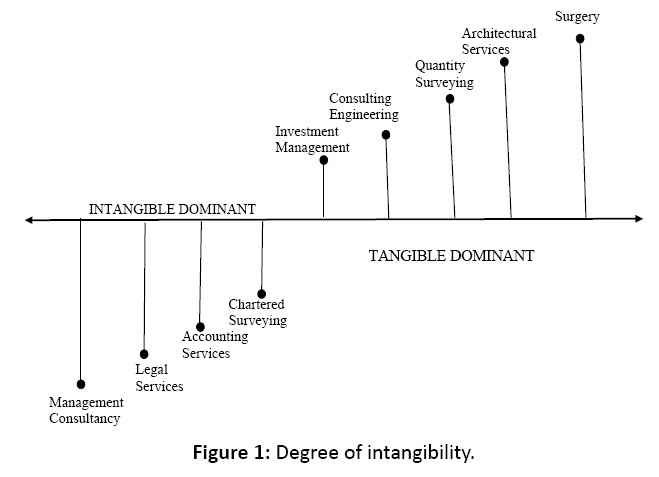
Figure 1: Degree of intangibility.
Some Scientists, suggests that quality actually depends on many factors that cannot be fully controlled by the service supplier, such as the ability of the consumer to articulate his or her needs, the ability and willingness of personnel to satisfy those needs, the presence (or absence) of other customers, and the level of demand for the service. Because of these complicating factors, the service manager cannot always know for sure that the service is being delivered in a manner consistent with what was originally planned and promoted [17].
Perishability
A researcher states that Perishability of services means that they cannot be stored for later sale or use. If a service is not used when available then the service capacity is wasted. For example, an empty seat on a particular flight from South Africa to Dubai cannot be sold to a passenger leaving on a later flight to Dubai. This characteristic of the service delivery process can cause severe problems if the demand for services (emergency room in a hospital) is not uniformly distributed over time. Strong demand fluctuations require excess capacity and careful planning at the level of the service provider. The fact that services cannot typically be returned or resold also implies a need for strong recovery strategies when things do go wrong [18].
A Scientist, documents that the role played by employees in providing excellent service quality cannot be overemphasized. They are an important and inseparable part of the service organization which depends on them to be in tune with the needs of their customers for purposes of designing and delivering services or products. Employees in a service organization serve as representatives of both the organization and their products or services to the customer responsible for creating value for customers and delivering excellence in service quality [19].
A researcher also referred employees as first customers of the service organization and they are recognized as the most crucial asset of today’s organization. According to scientist employees who are satisfied with their jobs will be more likely to purchase products from their employer than from a competitor. This way, they can also influence purchase behavior of other customers. Similarly, employees of an organization can be considered as internal customers who, like external customers, are looking to get their needs satisfied [20].
Researcher’s urges that satisfied employees tend to be more involved, dedicated, have greater organizational commitment, more loyal and productive towards customer needs, thus enhancing customer satisfaction, which is the ultimate aim of businesses today. According to scientists delivering superior customer value and satisfaction are critical to a firm’s competitive advantage. The relationships between employees within an organization are essential for the successful interactions with external customers. The delivery of quality internal services is critical to employee satisfaction since improvements in internal service quality are expected to produce improved external service quality. Schneider suggests that to create a quality service experience for consumers, service organizations must create a quality service experience for their employees [21].
Scientists found that employee satisfaction resulted in higher productivity and reduction in employee turnover. This study seeks to assess service quality in the dimension of employee behavior and attitude towards providing excellent service. High staff turnover could certainly have a bearing on service delivery and through customer surveys, research will show if service delivery is suffering at the hands of poor employee performance. Researchers posits that reduction in employee turnover lead to profits due to the cost savings in not having to constantly hire and train new employees [22].
In his Service scientists demonstrates positive relationship between employee satisfaction and customer satisfaction which in turn enhance firm’s profitability. He posits: Profit and growth are stimulated primarily by customer loyalty. Loyalty is a direct result of customer satisfaction. Satisfaction is largely influenced by the value of services provided to the customers. Value is created by productive employees. Employee loyalty drives productivity and loyalty is the outcome of satisfied employees. Employee satisfaction, in turn, results primarily from highquality support services of leaders and policies from organization that enable employees to deliver results to customers.
From the customer’s perspective, the behavior of employees can be assessed in providing health services. The overall performance of the employees has cumulative effect in ascertaining the perception of overall service quality
Researchers, suggests that service quality is the foundation for services marketing because the core product being marketed is a performance. The performance is the product; the performance is what customers buy. A stronger service gives companies the opportunity to compete for customers; a strong performance of the service builds competitiveness by earning customers’ confidence and reinforcing branding, advertising, selling and pricing. Scientists found that the customer’s perception of quality is not a one-dimensional concept. They identified five dimensions that a client considers in his or her assessment of service quality [23].
Exploratory research revealed that the criteria used by consumers in assessing service quality fit 10 potentially overlapping dimensions. These dimensions were tangibility, reliability, responsiveness, communication, credibility, security, competence, courtesy, understanding/knowing the customer, and access. These 10 dimensions and their descriptions served as the basic structure of the service-quality domain from which five items were derived for the current service quality (SERVQUAL) scale [24].
Various statistical analyses conducted in constructing SERVQUAL, revealed considerable correlation among items representing several of the original ten dimensions. In particular, the correlations suggested consolidation of the last seven dimensions into two broader dimensions labelled assurance and empathy. The remaining dimensions tangibles, reliability and responsiveness remained intact throughout the scale development and refinement process (Figure 2).
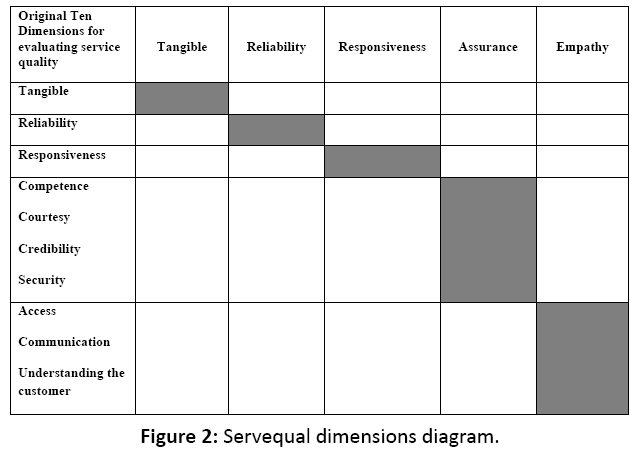
Figure 2: Servequal dimensions diagram.
Scientists have identified these five principle dimensions that customers use to judge service quality, which are listed and defined below in order of declining relative importance to customers. i) Reliability: The ability to perform the promised service both dependably and accurately. Reliable service performance is a customer expectation and means that the service is accomplished on time, in the same manner, and without errors every time. ii) Responsiveness: The willingness to help customers and to provide prompt service. Keeping customers waiting, particularly for no apparent reason, creates unnecessary negative perceptions of quality. If a service failure occurs, the ability to recover quickly and with professionalism can create very positive perceptions of quality. iii) Assurance: The knowledge and courtesy of employees as well as their ability to convey trust and confidence. The assurance dimension includes the following features: competence to perform the service, politeness and respect for the customer, effective communication with the customer and the general attitude that the server has the customer’s best interests at heart [25].
Empathy
Some documents that the provision of caring, individualized attention to customers. Empathy includes the following features: approachability, sensitivity, and effort to understand the customer’s needs. v) Tangibles: The appearance of physical facilities, equipment, personnel, and communication materials. The condition of the physical surroundings (e.g. cleanliness) is tangible evidence of the care and attention to detail that are exhibited by the service provider. This assessment dimension also can extend to the conduct of other customers in the service (e.g. a noisy guest in the next room at a hotel) from researchers use these five dimensions to form an assessment of service quality, based on the comparison between expected and perceived service. The gap between expected and perceived service is the measure of service quality Figure 3 illustrates this but also shows that customer expectation of a given service is formed or influenced as a result of many factors, word of mouth, personal needs, past experiences and external communication [26].
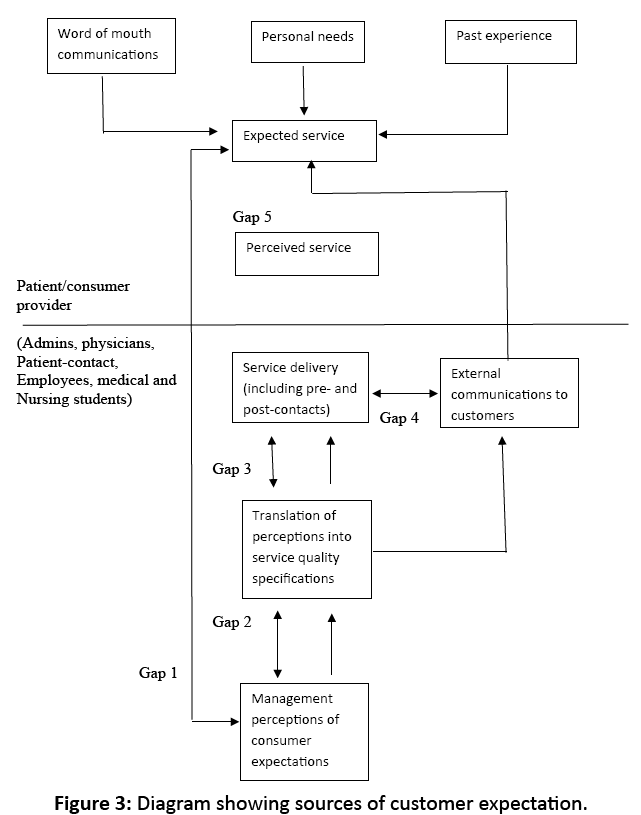
Figure 3: Diagram showing sources of customer expectation.
Given the importance of understanding customer expectations in order to deliver service quality, it is also clearly important to understand how such expectations might be formed. Finding out what customers expect is essential to providing service quality. According to researchers there are five dimensions to service quality [27]. These are explained below:
Dimensions of service quality, reliability, responsiveness, assurance, empathy, tangibles, word of mouth personal needs, past experiences, external communications, expected services (ES), perceived services (PS).
Perceived Service Quality: 1. Expectations exceeded ESPS (Unacceptable quality).
Scientists documents that Customers will have their expectations shaped, in part by word-of-mouth communications about the service provider, effectively, this relates to communication from sources other than the service provider itself. Friends, family, colleagues are obvious sources in this context. Equally, the media may be a source of such communication as may other organisations such as inspection and audit agencies and central government. An important question for a service is: does the service provider know what others are saying about their service? [28]
A Scientist differs from some researchers in the sense that he argues that while a professional service provider cannot directly control what one client tells another, he or she can influence it, an example, of a hospital that gains a new patient as a result of a personal reference from an existing customer, the hospital can send the referring customer a note of thanks, thereby encouraging such positive word of mouth [11].
According to some Scientists, any customer will have what they regard as a set of key personal needs which they expect the service to address. Clearly these will vary from service to service and importantly – from customer to customer. An inadequate understanding by the service of these personal needs will make it difficult to design an appropriate service. Professional service providers must be aware of personal needs and desires of their clients. Client expectations can shift as a result of the circumstances surrounding the need. An example, the husband of an expectant woman having pre-labour pains who brings that woman for Ante Natal Care may be willing to wait a reasonable time, say 20 min, especially if there were other woman with the same condition crowding the doctor’s waiting room. On the other hand, if that same husband’s wife were on the verge of delivery the husband would expect immediate attention [29].
Researchers observes that some customers many for some services will be “repeat” customers in the sense that they have used the service before. Their previous experience as a customer will, in part, influence their expectations of future service. One customer, for example, may have low expectations because of previous poor service. Another may have high expectations because the service quality last time was high. Accounts commission of Scotland differs from the previous scholar and reports that, some customers may also use their previous experience of other organisations in this context. Another factor that would be influenced by past experience is perceived service alternatives. Scientists reports that the more competitors a professional service provider has and the more clients are aware of their existence, the greater the expectations of quality service. Clients are not likely to put up with poor service when they can get better attention across the street [30].
This influencing factor can be divided into two subcategories: Explicit external communication and implicit external communication. Explicit Communication – relates to statements about the service made by the service itself. Such statements may come from service staff or from the service in form of leaflets, publicity and organization material. The clients’ expectations will obviously be affected by what they are told they can expect. Implicit Communication because services are intangible, clients will look for some other clues as to the potential quality of the service. They look at the physical evidence provided by the professional service provider and the price they will be charged for services. An office furnished with Persian rugs, etched glass and fine art may communicate that a professional service provider is successful, and also expensive. Because there is an implied price-quality relationship, a higher price implies a higher quality. Thus, clients who are willing to pay higher fees do so because they expect a greater amount of attention and a more positive outcome
According to scientists, the central focus of the gaps model is the customer gap, i.e., the difference between customer expectations and perceptions. Expectations are the reference point’s customers have coming in to a service experience; perceptions reflect the service as actually received. The idea is that businesses will want to close this gap between what is expected and what is received – to satisfy their customers and build long-term relationships with them. To close this allimportant customer gap, the model suggests that four other gaps – the provider gaps – need to close. The provider gaps are the underlying cause behind the customer gap: Gap 1 – Not knowing what customers expect. Gap 2 – Not selecting the right service designs and standards. Gap 3 – Not delivering to service standards. Gap 4 – Not matching performance to promises [22].
The consumer evaluations of service quality centre on the balance of their expectations and perceptions of a service. Expectations that are met or exceed in a service encounter, or series of service encounters, will result in adequate or ideal service quality evaluations. Alternatively, expectations that are not met will result in negative service quality evaluations. The service quality gap model in Figure 4 provides a framework for organisations seeking to systematically improve consumer perceptions of service quality Figure 4 illustrates five gaps as mentioned. Gap 5, the difference between consumer expectations and perceptions is a direct reflection of Gap 1-4. This means that the smaller the discrepancy observed in Gaps 1-4, the more likely consumers will favourably evaluate service quality.
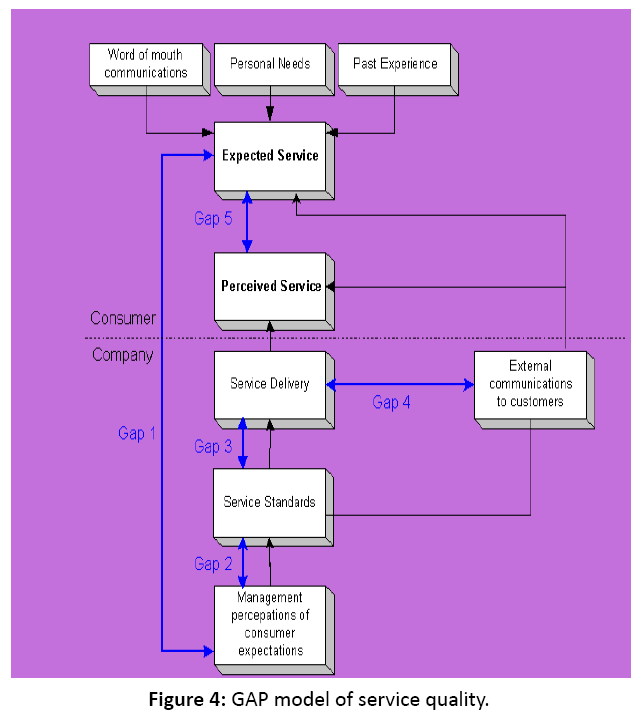
Figure 4: GAP model of service quality.
A primary cause in many firms for not meeting customers’ expectations is that the firm lacks accurate understanding of exactly what those expectations are scientists also concurs when he says understanding customer expectation is crucial for quality. Understanding customer expectations is a prerequisite for delivering superior service; customers compare perceptions with expectations when judging a firm’s service. Researchers continued to evolve their conceptual model. The author’s prime contribution was the development of the zone of tolerance concept. Conceptually, the zone of tolerance is an area between a customers’ adequate service level and the desired service level. For example, when one uses a laboratory department in a hospital, their desired service level, in regard to waiting time, is most likely zero minutes. In order for the hospital to keep them as a customer, they, on average, may not want to wait longer than 1 h – the adequate service level. The difference between zero wait time and a 1 h wait time is the zone of tolerance. As Figure 5 shows below, there are a number of factors that can be affected by situational factors. For example, if a major motor vehicle accident has occurred involving a large number of people, the doctors using the laboratory (laboratory customers) are willing to wait a little longer for blood results due to the unforeseen situation and the larger work volume. Due to their past/everyday experience they expect results quickly because of the explicit service promises given by the laboratory that guarantee a 1 hour turn around for urgent work. This new model is based upon the following two propositions: (1) Customers access service performance based on two standards: what they desire and what they deem acceptable and (2) Researchers also agrees by bringing in the issue of zone of tolerance. A zone of tolerance separates desired service from adequate service. The model highlights an outcome where performance or perceived service that is below adequate is a competitive disadvantage. An outcome where the perceived service falls between adequate and desired expectations, within the zone of tolerance, would be classified a competitive advantage [31].
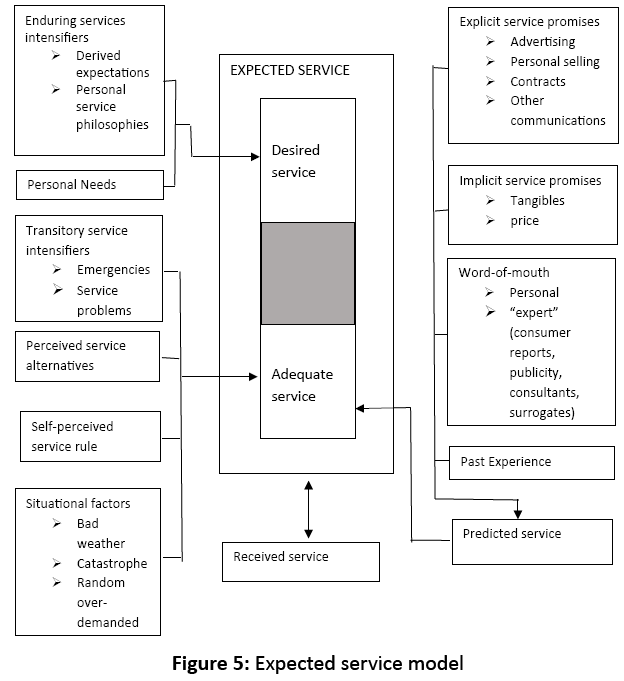
Figure 5: Expected service model
Researchers postulated, but did not test, that both adequate and desired service levels will be influenced by the importance attached by consumers to the dimensions of service quality, as will the width of the zone of tolerance. They suggested that both desired and adequate expectation standards would be higher for those dimensions of service quality considered to be more important and the zone of tolerance would be smaller for more important dimensions.
The customer gap (Gap 5) is the focal point of this dissertation. Empirical data obtained from consumers’ results of SERVQUAL, will be used to look at the relationship between the five dimensions that customers’ use to form their expectations and perceptions of the service and to identify the key areas of strength and weakness in the service quality delivery process of a private hospital in the Middle East. Using the statistical data and customer feedback obtained from the surveys for the different dimensions of service quality, the zone of tolerance for each of the five dimensions will be determined. This idea is also supported by researchers [32].
According to Fitzsimmons and Fitzsimmons measuring service quality is a challenge because customer satisfaction is determined by many intangible factors. Unlike a product with physical features that can be objectively measured (e.g. the fit and finish of a car), service quality contains many psychological features (e.g. the ambience of a restaurant). In addition, service quality often extends beyond the immediate encounter because, as in the case of health care, it has an impact on a person’s future quality of life [33].
Researcher documents that finding out what customers expect is essential to providing service quality, and research is a key vehicle for understanding customer expectations and perceptions of services. In services, as with any offering, an organization that does no research at all is unlikely to understand its customers. A firm that does research, but not on the topic of customer expectations, may also fail to know what is needed to stay in tune with changing customer requirements. Marketing research must focus on service issues such as what features are most important to customers, what levels of these features customers expect, and what customers think the company can and should do when problems occur in service delivery.
Scientists submit that high service quality appears to result in measurable benefits, sometimes directly detectable as increases in profits and market share. An American think tank called the Strategic Planning Institute of Cambridge, Massachusetts has compiled data concerning 2600 firms over the last 15 years. The results of their research have shown that the perceived quality of a company’s goods and services is directly tied to financial performance. In particular, they found that, from almost any performance measure – including market share, return on investment and asset turnover – those businesses that offer higher quality perform better. Among the most powerful tool for shaping perceptions of overall quality is customer service. The point is simply that quality measurement and customer satisfaction deserve special attention if service firms are to remain competitive [34].
Researchers reports that market research methods can be divided into primary and secondary data collection. Primary data collection refers to data collected for the first time, such as through interviews or questionnaire surveys, whereas secondary data are taken from other sources that have already carried out primary data collection. The most widely used and tested service quality survey instrument has been SERVQUAL.
Many criticisms of the SERVQUAL scale have appeared over recent years: some scientists argued that it confuses outcome, process and expectation; Chen et al. stated that it neglects the price factor and suffers from multicollinearity due to the averaging of measured gaps; Carmen argued that it is not generic and needs to be customised to the service in question. He also suggests that the instrument could only be used as a guide to research service quality in various industries. He also suggested a problem exists in treatment of expectations where a respondent error could exist due to different interpretations of questions. Expectations could be rated according to their importance, as forecasts, ideal, deserved and/or as minimum tolerable.
Brown et al. reported psychometric problems with the use of the difference scores and suggested that the five dimensions may in fact represent a one-dimensional construct. Another matter suggests that the model should not be limited to the five dimensions proposed by researchers. Up to seven or eight dimensions have been identified by various researchers in a variety of studies. The validity of the dimensions was also shared by scientists and continues to be debated, but researchers, state that the model is generic (a skeleton) and dimensions will change from one industry to another [35].
Researchers argue that this negative perception of expectations, or the term they use “disconfirmation paradigm” that SERVQUAL instrument applied in determining service quality was inappropriate for measuring service quality. They pointed out that this “disconfirmation paradigm” measures customer satisfaction instead of service quality. In their study, Cronin and Taylor used the performance scale (SERVPERF) and found that SERVPERF outperformed SERVQUAL. Researchers indicate that SERVPERF was a more appropriate measure, because they felt that consumer satisfaction has a greater influence over the purchase intentions of the consumer, than service quality [36].
Despite numerous suggestions regarding reappraisal and restructuring, expectations of what service quality might be – fed by the sheer mass of scientists - inspired literature – have now become the standard perceptions of what service quality really is; and this perception continues to inform mainstream service quality research today. Even where work is primarily focused on the technical and functional aspects of service quality, the SERVQUAL dimensions may still be used to inform, or even determine, their structure. Foster, supports Woodall in that this instrument has been widely used in many service industries, including hotels, dentistry, travel, higher education, real estate, accountancy, architecture, hospitals and construction services.
SERVQUAL is an instrument “for assessing customer perceptions of service quality in service and retailing organisations”. Exploratory research conducted in 1985 showed that clients judge service quality by using the same general criteria, regardless of the type of service. Researchers captured these criteria using a scale composed of 22 items (statements) designed to load on five dimensions reflecting service quality as defined by its authors. Each item is used twice: firstly to determine customers’ expectations about organizations in general, within the service category being investigated; secondly to measure perceptions of performance of a particular firm. The 22 statements in the survey describe aspects of the five dimensions of service quality. The evaluations of these 22 statements are collected using a five Likert scale. According to scientists the service quality is then the difference between customers’ perceptions and expectations.
According to a researcher concerns with quality of services in healthcare sector and its measurement are not at all new. “As long ago as 1854, Florence Nightingale demonstrated that a statistical approach with graphical methods could be persuasive in reducing the cost of poor quality care by 90% within a short period of time”.
Scientists, argues that Service quality has been increasingly identified as the key in differentiating services and building competitive advantage .Therefore, understanding, measuring and improving quality is a formidable challenge for all organisations since they compete to some degree on the basis of service. The bottom line for strategic advantage in health care is quality. People are not as accepting now as say ten years ago. The high cost for health care services and legal backing has placed a greater emphasis on service providers (nurses, doctors and hospitals) to deliver a thorough high quality service to the customer. Patients now have a preconceived standard of quality before arriving at a hospital and therefore the understanding between the customer and provider needs to be understood clearly.
Researchers emphasized that in the healthcare industry, hospitals provide the same types of service, but they do not provide the same quality of service. Furthermore, consumers today are more aware of alternatives on offer and rising standards of service have increased their expectations. They are also becoming increasingly critical of the quality of service experience. Service quality can therefore be used as a strategic differentiation weapon to build a distinctive advantage which competitors would find difficult to copy. To achieve service excellence, hospitals must strive for “zero defections”, retaining every customer that the company can profitably serve. “Zero defections” require continuous efforts to improve the quality of the service delivery system.
Researchers identified that the service providers in health care increasingly have to deal with a wide range of social, financial, political, regulatory and cultural challenges, the impact of which, among other factors, is the demand for greater efficiency, better quality and lower costs. Hence, quality management has emerged not only as the most significant and enduring strategy in ensuring the very survival of organisations, but also a fundamental route to business excellence. Moreover, due to the availability of information and a better-educated population, the need to measure up is no longer a choice but a necessity in meeting rising expectations from better-informed customers.
Knowing what the customer expects when they use health care services is ultimately the way to create good service quality. Doing market research amongst the health care users to determine their expectations and perceptions of services would give managers the strategic leap necessary to meet those customer expectations in their own organisation. The strategic advantage is to understand the customers’ needs and then make the changes to deliver that exceptional service. As mentioned earlier, customers today are well informed and know what they want. They would therefore have clear and precise needs that they would expect from any organisation. Scientists argue that “in the healthcare sector, marketing has grown beyond the point of being neglected. Increased competition for both patients and funds has forced some organisations, more specifically hospitals, to become more market-oriented. Resistance against marketing has diminished over time, and more and more hospitals and healthcare organisations now accept marketing as a valid management function.” Yet, despite these motivations, service quality in healthcare is poorly understood and insufficiently explored. The question is where do hospitals and clinics start? Obviously they need not reinvent the wheel; others know a great deal about service quality and hospitals and clinics can learn from them.
Scientists say that most professionals recognise the value of information gathering in managing business. Yet they attach less importance to conducting formal research. Many fall prey to the “just talk to people” syndrome. Although no one would argue that professionals should be talking with current and prospective customers, there are serious problems in relying on this method of gathering “information” Firstly, the individuals they speak to may not be representative of their customer group. What has tended to happen is for hospital or hospital administrators have a tendency to talk to people who are similar to them, and therefore the information that is collected by “just talking to people” is likely to support the interviewer’s preconceptions. This approach also typically is characterised by biased interviewing techniques. Finally, there are likely to be inconsistencies between how individuals are asked questions. A well-planned research program should eliminate these problems [12].
Research design
A descriptive research design was adopted for this his study. According to a research design is “a strategic framework for action that serves as a bridge between research questions and the execution or implementation of the research.” Scientists concur with the above assertion when he says “a research design is the arrangement of conditions for collection and analysis of data in a manner that aims to combine relevance to the research purpose with economy and procedure.” In this study the research design contained the target population, sample size, the sampling technique, the research instrument, data collection procedure and data presentation and analysis that the researcher used in this research.
Descriptive research design
Scientists observe that descriptive research refers to the type of research question, design and data analysis that will be applied to a given topic. “Descriptive research tells us what is indeed good description provokes the `why' questions of explanatory research”. If as researchers “we detect greater social polarization over the last 20 years (i.e., the rich are getting richer and the poor are getting poorer) we are forced to ask `why is this happening? This is the explanatory aspect of the research.
The descriptive research design was adopted as it gives the reader information about what is going on in the area of study. According to scientists the other advantages of a descriptive research design are that it is cost effective, fast and easy to generate hypothesis for further studies.
Research approach
The research approach for this study was qualitative and it involved gathering data on the opinions, ideas and perceptions of respondents on the service quality expectations and perceptions of Antenatal Care patients in Mberengwa District.
Mouton argues that the qualitative approach is a multiperspective approach to social interaction, aimed at describing, making sense of, interpreting or reconstructing this interaction in terms of the meanings that the subject attaches to it or representing people, actions and events in social life. Mouton’s view is supported by McMillan and Schumacher who say that the ultimate goal of qualitative research “is to portray a complex pattern of what is studied in detail so that one who has not experienced it can understand it.”
In this study the researcher deliberately adopted a combination of both quantitative and qualitative research approaches. First, the researcher felt that a qualitative component of the study would best meet the aim of discovering and understanding the opinions, beliefs and ideas of what the stakeholders said about quality service expectations and perceptions in Mberengwa District. The researcher also believed that a qualitative research approach was the method best suited to investigate the challenges and experiences that ANC patients came across while discharging their duties as it allowed the researcher to observe the participants within the context of their own world. The qualitative approach however has the following limitations:-
It can be time-consuming and demanding as the data obtained through it is voluminous. There are chances of human bias and error because the researcher becomes immersed in the phenomenon being studied. However in this study the researcher tried as much as possible to be detached from the phenomena by asking objective questions.
Despite the above limitations the researcher felt a need to use this method because it was concerned with understanding behavior from the research subjects’ frame of reference. A scientist asserts that qualitative research is oriented towards analyzing concrete cases in their temporal and local particularity, starting from people’s expressions and activities. The fact that this was a case study provided a detailed description and analysis of processes or themes voiced by participants in a particular situation. A researcher supports this view by saying “in this way data are gathered directly from individuals in their natural environment in order to study their interactions, attitudes and their characteristics.” This promotes self-understanding and increases insight into human existence.
The second approach used by the researcher was quantitative, which researcher say “quantitative research methods are used when something needs to be measured, while qualitative methods are used when a question needs to be described and investigated in some depth.” Quantitative data collection techniques made it possible to collect information from quite a number of respondents and allowed the researcher to follow the original set of research goals, quantify responses from respondents, achieve high levels of reliability of gathered data due to mass surveying and arrive at more objective conclusions by minimizing subjectivity of judgement.
Howard and Sharp say when conducting research, the first step is to define the population to be studied in terms of its geographical, demographic and other boundaries to decide whether it should be fully or partially covered. According to a study population or target population therefore refers to “the group about which the researcher wants to gain information and draw conclusions.” Put differently it is the entire group of subjects to whom researchers wish to generalize the findings of a study, including persons who did not participate in the study. In support of researcher view, posit that “population parameters and procedures are of paramount importance when conducting research and become critical as a factor in the success of any study.” In this study the population consisted of 110 ANC patients as depicted on Table 1.
| Category | Target population | Sample size |
|---|---|---|
| ANC patients | 110 | 103 |
| Total | 110 | 103 |
Table 1: A study population or target population.
Sample size
According to scientists “sampling denotes a fraction in the population which is selected for investigation in order to make inferences or claims about the population under investigation.” In this study the sample consisted of 103 Ante Natal Care patients attending ANC services at Mberengwa District Hospital.
Sampling technique
A sample is a subset of subjects that is representative of the entire population. The sample must have sufficient size to warrant statistical analysis. In this study sampling was done because it was impossible to test every single subject in the population, sampling was also done to save time, money and effort while conducting the research, the minimum sample size for this study was put at 103 patients.
Purposive sampling
The study employed judgmental sampling technique. According to Kumar the primary consideration in judgmental sampling is the judgment of the researcher as to who can provide the best information to achieve the objectives of the study. In this study the researcher relied on his experience in public health issue in the Mberengwa District in order to select Mberengwa district hospital as the study area, thus the researcher chose Mberengwa District Hospital as most ANC patients visit this referral health facility.
As for the sampling technique used in selecting who to distribute the questionnaire to the researcher used the convenience sampling technique. A convenience sample is “either a collection of subjects that are accessible or a self-selection of individuals willing to participate which is exemplified by your volunteers.” The subjects are selected “just because they are easiest to recruit for the study and the researcher did not consider just selecting subjects that are representative of the entire population”. The convenience sampling technique became ideal because the research occurred around the time when ANC patients were busy visiting their clinic for ANC services. Secondly the researcher decided that a bigger Health Care facility like Mberengwa District Hospital would have enough patients from whom to gather data hence no resources would be wasted in visiting individual ANC patients at their homesteads.
Research instrument
According to a research instrument is “a tool used to collect data as well as a tool designed to measure knowledge, attitude and skills.” In this study the research instruments that were found to be ideal was the questionnaire.
The manner in which data are collected is a crucial aspect of the research study as it determines its success or failure. As mentioned earlier, the study involved a case study of the opinions, ideas and perceptions of ANC patients on the service quality expectations and perceptions by ANC patients in the Mberengwa District. Smith cited in Merriam points out that “case studies are differentiated from other types of qualitative research in that they are intensive descriptions and analyses of a single unit or bounded system such as an individual, organization, place, programme, event group, intervention or community.”
According to scientist a questionnaire is “a list of written questions which can either be open-ended or closed ended used to gather responses on particular issues from the respondents.” The following were some of the advantages that made the researcher opt for a questionnaire, firstly the respondents could be asked to complete the questionnaire during their own time or when it was convenient to them with the researcher not present. Secondly the questionnaire made it possible to have a bigger sample size unlike the situation if interviews had been used, thus the questionnaire made it possible to gather the views of a larger sample size.
Thirdly the questionnaire provided large varied amounts of appropriate and easily comparable data at a low cost per respondent, than would have been the case with interview. The respondents had the freedom of private response to more personal questions as they were provided with enough time to answer the questions. The questionnaires provided a reliable, practical and effective way of collecting data that could easily be managed by the researcher, especially in instances where the respondents were busy, it was just easy to administer the questionnaire to the respondent. Finally being rural set up with a poor postal service the self-administered questionnaire was found to be easy to use the questionnaire as a data gathering tool, as there would be no need to phone, Skype or use any sophisticated means of data collection.
The respondents in this survey were pregnant women attending ANC services at Mberengwa district Hospital.
The questionnaires were divided into five sections, based on themes derived from the objectives (Annexure A).
The study utilized semi-structured in-depth individual interviews with some respondents as they preferred the researcher to personally interview them while capturing the data. For this the researcher just used the questionnaire hence the reference to the structured questionnaire. The interviews with the ANC patients were done to provide insights into their opinions on the service quality expectations and perceptions by ANC patients in Mberengwa district.
Data gathering and collection
The questionnaires were administered personally by the researcher to the various ANC patients.
Ethical considerations
According to scientists ethics basically refers to a system or set of moral principles suggested by a group or individuals and accepted to offer rules and behavior expectations. Ethics imply preferences that influence behavior in human relations. Quite often “ethics go hand in hand with values which deal with issues pertaining to what is right or wrong and what is good and desirable.”
Ethical aspects addressed by the researcher included seeking authority to conduct this research, respect for the respondent’s freedom, volunteerism, confidentiality and respect for person’s freedom. The researcher felt it was important to give weight to the ethical issues as failure to do so would have resulted in respondents failing to cooperate with her and thus stalling the whole research process.
Permission
Literature indicates that the process of gaining access to enter into a research site and getting permission to select subjects is viewed as a vital aspect of research. In this study, preparations to seek permission to conduct the study were dealt with well ahead of the date for the commencement of the actual study. A letter to the District Medical Officer was written and presented to his Offices requesting authority to conduct this research well in advance.
The right for self-determination
The right to self-determination was fully observed by the researcher and this was demonstrated by requesting the subjects to volunteer to participate in the study at their free will. Indeed all subjects were politely asked to participate by the researcher prior to the study as subjects were adequately informed about the nature of the study and they were free to withdraw anytime during the period of study.
Anonymity
Principles of anonymity involved separating subjects from the information they were giving by requesting them not to write their names on any of the papers they handled. All respondents were advised not to disclose their identity. The researcher assured the respondents that all the information regarding the study would be kept nameless.
The right to decide to participate
The right to decide to participate is based on the ethical principle of self-determination which basically is the participant’s moral right to make a decision concerning participation in the study. The researcher practiced the expected professional obligation to fully and truthfully inform participants, the purpose of the study; consequences if there were any gains or any possible risks so that participants could make appropriate decisions.
The right to privacy
The right to privacy is regarded as a personal value which entails the individual’s right to decide when, where, to whom and to what extent the person’s attitudes, beliefs and behaviour could be revealed. In this study the privacy of participants regarding the information and their identity were maintained and safeguarded with absolute care. Once again it must be emphasised that the researcher acted with the necessary precaution where the privacy of participants was relevant
Reliability and validity
Reliability means that any significant results from a research must be more than a one-off finding and be inherently repeatable. Researchers note that the tendency towards consistency found in repeated measurements is referred to as reliability. Researcher’s states that reliability is a matter of what a particular technique, applied repeatedly to the same object, would yield the same results each time it is administered. It means that, using the same method, the same information will be collected each time in the repeated observation of the same event. In this study the researcher ensured the reliability if the data, by getting the demographic details of the respondents, so that the data these respondents would provide would be reliable as they were based at the community of the case study and they had the requisite experience and educational qualifications to be able to answer the questionnaire and provide factual and reliable answers for this particular research.
Validity refers to the degree to which a test measures what it purports to measure. In this study the researcher enhanced the validity of the research by taking note of the research objectives, making sure the questionnaire addressed the themes highlighted in the objective and analyzing data and arriving at conclusions and making recommendations basing them on the themes obtained from the objectives.
Data presentation and analysis
According to researcher’s data analysis is “a process of systematically searching and arranging the completed questionnaires, the interview transcripts, field notes and other materials accumulated to increase the understanding of them and to enable the researchers to present what has been discovered to others.” Mouton defines data analysis as the “breaking up of the data into manageable themes, patterns, trends and relationships”. Scientists asserts that data analysis involves “organizing what you have seen, heard, and read so that you can make sense of what you have learned.” In qualitative research data collection and analysis are interactive processes that occur in overlapping cycles. In order to focus and shape the study as it proceeded, the researcher began a tentative data analysis process while collecting the data in order to avoid playing ‘catch-up.’
The raw data were first arranged in tables and tallied as per respondents’ answers, these were summed up and the frequencies collected. The researcher then embarked on a more detailed and fine-grained analysis of the collected data. The data were compared, categorized, patterns and trends identified, divergent responses, possible explanations and propositions recorded. Comparisons across the categories were made in order to discover connections between themes. Ideas and facts that developed initial patterns were analyzed and noted for further development and testing of final themes in subsequent data analysis.
After the data had been analyzed and the researcher interpreted it, some of the data was then arranged into pie charts, bar graphs and line graphs. This according to Mouton “relating one’s results and findings to existing theoretical frameworks or models and showing whether these are supported or falsified by the new interpretation.”
Finally it might be pertinent to emphasize that there is often a misconception that qualitative research and data analysis is ad hoc, intuitive, unsystematic and thus without academic rigor. This analysis intended to challenge this notion firstly by explicitly stating that the supervisor and the researcher worked as a team and with rigor. Secondly, both qualitative and quantitative data were be used to complement each other in this research.
This section presents the results of the study primarily from the questionnaires which were circulated and interviews that were conducted by the researcher. One questionnaire was constructed for Ante Natal Care (ANC) patients at Mberengwa District Hospital. A total of 103 questionnaires were selfadministered by the researcher to ANC patients who participated in the survey. The questionnaire had a total of 32 list type questions; this was deliberately done to encourage respondents to participate as too many open ended questions would have very negatively affected the response rate of the respondents. The data was then collated and tabulated into the statistical program SPSS following which the results were first tallied and then presented from tables, bar charts to column charts and pie charts. Tables were also utilized to extrapolate information from excel. Furthermore cross tabulations were employed to search for different relationships between the various variables. In addition to analyzing data on the closed ended questions, the researcher looked for key words and phrases in the open ended questions and the interviews to capture that data.
With a questionnaire as the main research tool to gather data from the respondents, the first section of the instrument was intended to gather data on the biographic details of the respondents. Frequency tables were utilized in analysing the data gathered from the respondents. Secondly the researcher was also trying to establish the respondent’s categories, the number of questionnaires distributed per each stratum and the response rate per stratum as well as the overall response rate for the whole survey. Thirdly it was also the researcher’s view that the personal details of the respondents would be important to establish so as to make sure he was gathering data from the rightful respondents, quite frankly this would help to enhance the reliability of the data within the entire survey as the right respondents would naturally have the most appropriate answers for this study
This section sought to establish the bio-graphic details of respondents, indeed information about the demographic background of ANC patients who were sampled for the purpose of this study covered a wide range of characteristics such as their pregnancy status, whether this was their first pregnancy, respondents’ educational qualification and whether this was their first pregnancy.
Table 2 revealed that 110 questionnaires were distributed to all respondents who comprised of ANC patients, only 70 responses were received which brought the overall response rate to 63.64%. Castillo points out the statistical significance of a response rate and says a response rate above 60% is quite significant, particularly where there is such a wide spatial distribution of respondents as the ANC patients at Mberengwa District Hospital. The above data revealed that participants were moderately excited to participate in this survey (Table 3).
| Category | Distributed Questionnaire | Overall Response Rate | ||
|---|---|---|---|---|
| Freq | % | Freq | % | |
| Ante Natal Care Patients | 110 | 100 | 70 | 63.64 |
| Total | 110 | 100 | 63.64 | |
Table 2: Shows the respondents ‘category, questionnaires distributed, the response rate per category and overall response rate for the whole survey.
| Category | Freq | % |
|---|---|---|
| Are you pregnant (N=70) | ||
| Pregnant | 70 | 100 |
| Not pregnant | 0 | 0 |
| Age (N=70) | ||
| Below 18 | 1 | 1.43 |
| 18 to less 25 years | 15 | 21.43 |
| 25 to less than 32 | 49 | 70.00 |
| 32 to less than 39 | 5 | 7.14 |
| Over 39 years | 0 | 0.0 |
| Is this your first pregnancy? | (n=70) | |
| Yes | 23 | 32.86 |
| No | 47 | 67.14 |
| Indicate whether you are in-patient or out patient | (N=70) | |
| In-patient | 0 | 0 |
| Out patient | 70 | 100 |
| Indicate number of visits | (N=70) | |
| 1 to 2 | 20 | 28.57 |
| 3-4 | 13 | 18.57 |
| 5-6 | 37 | 52.86 |
| Over 6 | 0 | 0.00 |
| Highest educational Qualification (N=70) | ||
| Primary School | 0 | 0.00 |
| Secondary School | 49 | 70.00 |
| Diploma | 14 | 20.00 |
| Degree | 5 | 7.14 |
| Post Grad | 2 | 2.86 |
Table 3: Demographic details of respondents.
Confirm you are pregnant
Virtually all (100%) respondents confirmed their pregnancy status, meaning everyone who participated in the survey was pregnant hence this adds to the reliability of the gathered data.
Age of respondents
While the 70% of respondents within the ANC patient’s category fell within the 25 to 32 years age group, 21.43% of respondents within the ANC patient category fell within the 18 to 25 year age group. Only 1.43% of the respondents were below the age of 18years and none of the respondents were over 39 years of age. Overall the majority of the ANC patients were aged between 25 to 32 years which showed that the majority of respondents were in the reproductive age group.
Whether this was the respondent’s first pregnancy?
On the question of whether this was the respondent’s first pregnancy or not, up to 67.14% of respondents indicated that this was not their first pregnancy while the remainder confirmed that this was indeed their first pregnancy. The above data tended to suggest that the majority of the Ante Natal Care patients were seasoned and experienced mothers who had been through the birth process before hence this would give credibility to their answers.
Highest educational level
Seventy percent of the respondents held a secondary school education as their highest educational qualification, while up to twenty percent of respondents held a Diploma qualification as their highest educational qualification. Only 2.86% of the respondents had a post graduate educational qualification as their highest qualification and none of the respondents held a primary school educational qualification as their highest educational qualification.
The above statistics showed that virtually all the respondents were literate enough to read and understand the questionnaire and also appreciate the meaning of the contents. Most mothers were high school leavers this could be due to economic hardships like lack of school fees or neglected girl child or that they fell pregnant at school and dropped out
This section sought to establish the respondents’ expectation of service quality before treatment. Expectation levels were measured by asking the respondents’ questions on what expectations they did have of the level of helpfulness they expected to find at the receptionists at their local clinic.
An analysis of Figure 6 above revealed that 58.57% of respondents expected to find the Reception desk Very helpful, where as 18.7% expected to find the receptionist’s desk Fairly helpful. The third level of respondent’s category stated that they did not know what level of helpfulness they expected to find at the Reception desk. Finally the last lot of respondents indicated that their worry was the treatment they did not worry about the Reception Desk. From the above data the majority of respondents expected the Reception desk to be very helpful which means to them the assistance they got from the Reception desk was supposed to be as good as the treatment they good from the actual medical staff.
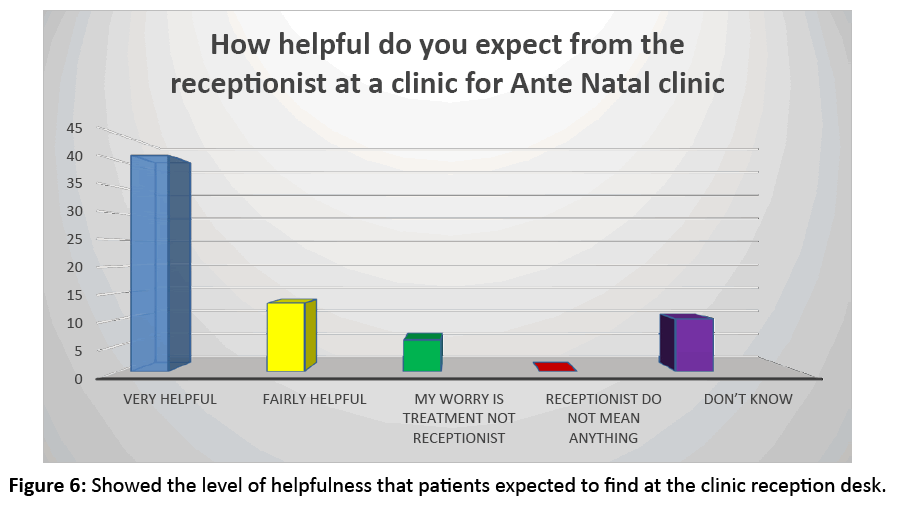
Figure 6: Showed the level of helpfulness that patients expected to find at the clinic reception desk.
This study took an interest on the easiness with which the ANC patient expected to get through on the phone at their local clinic or GP. An analysis of Figure 7 revealed that 78.57% of respondents felt they expected it to be very easy to get through to someone at their local clinic or GP on the phone.
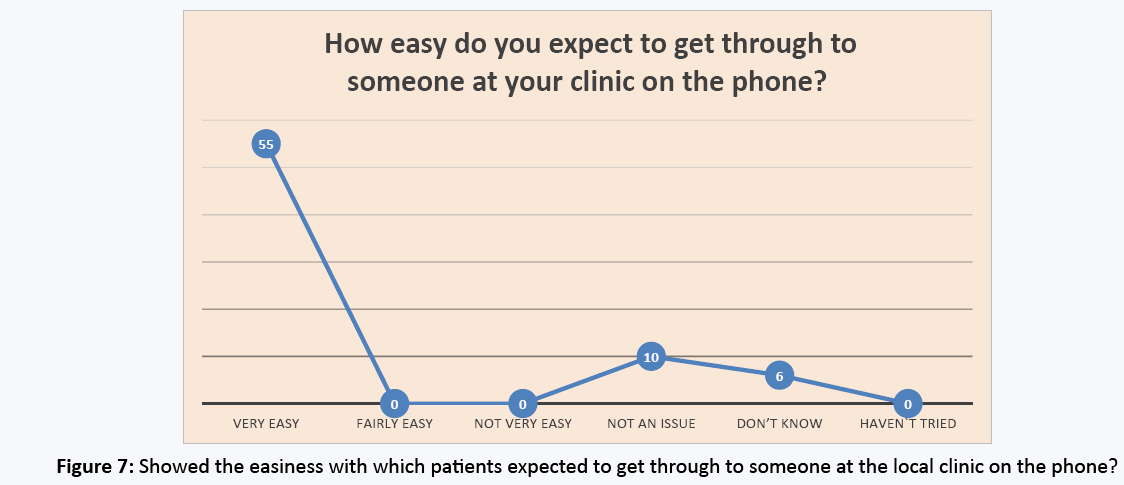
Figure 7: Showed the easiness with which patients expected to get through to someone at the local clinic on the phone?
Another lot of 14.29% of the respondents felt that how easy they expected to get through to someone at their clinic or GP practice on the phone was not an issue. However a third lot of respondents though indicated that they did not know how easily they expected to get through to someone at their clinic or GP practice on the phone. From the above data it was clear that the majority of respondents expected to get through on the phone Very Easily, which means that when the patients were in need of medical help their expectation was that the clinic facilities including the phones should enable them to get immediate help from a professional Health Care provider (Figure 8 and Table 4).
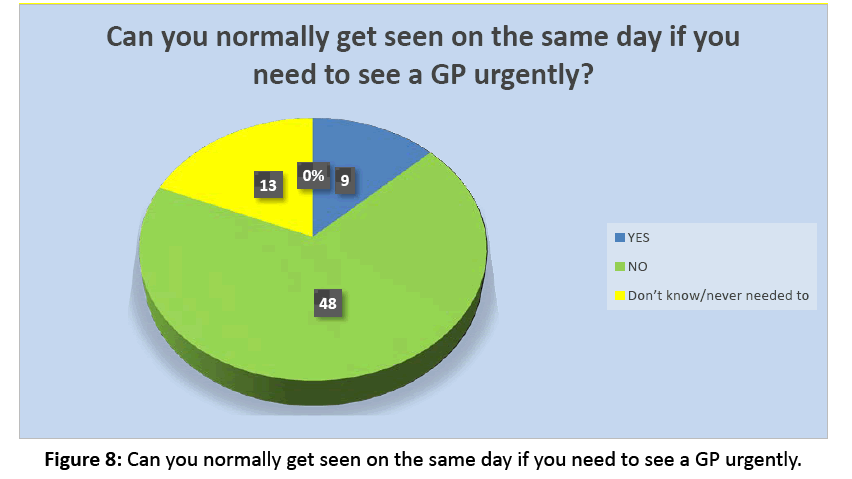
Figure 8: Can you normally get seen on the same day if you need to see a GP urgently.
| Variable | Freq | % |
|---|---|---|
| Yes | 9 | 12.86 |
| No | 48 | 68.57 |
| Don’t know/never needed to | 13 | 18.57 |
Table 4: Showed whether an ANC patient would normally manage to be seen on the same day.
An analysis of Figure 9 above revealed that of the 70 respondents who were ANC patients at Mberengwa district Hospital, 84.29% of them indicated that they thought that it was very important that they be able to book their appointment in advance, however the remainder (15.71%) of the respondents felt that it was not very important that they were able to book their appointment in advance. This result tended to reveal that for the majority of ANC patients it as very important that they booked their appointment in advance, as this would facilitate their seeing the Health Care provider in time without any delays (Figure 10).
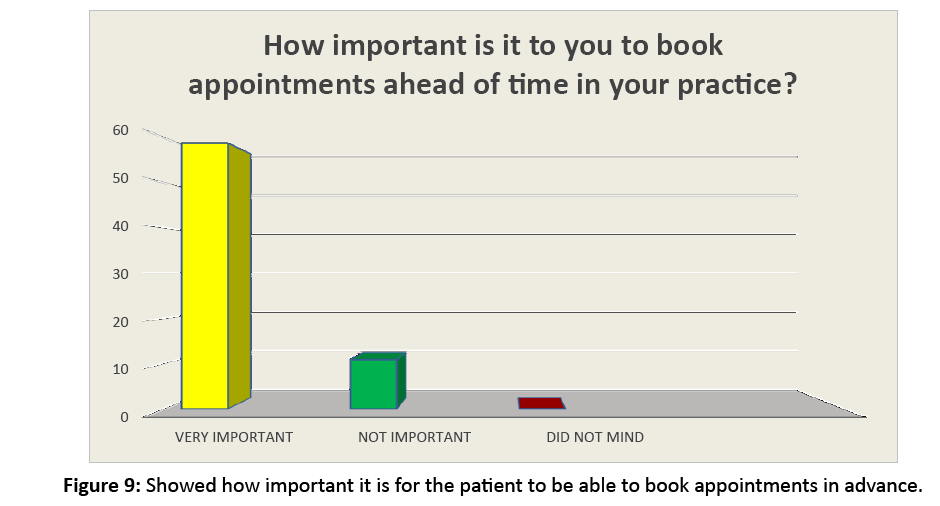
Figure 9: Showed how important it is for the patient to be able to book appointments in advance.
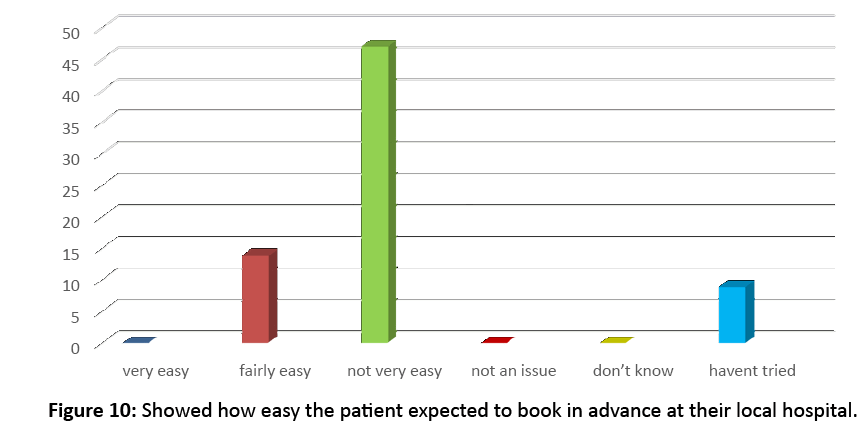
Figure 10: Showed how easy the patient expected to book in advance at their local hospital.
The study also took a special interest on the question of how easy ANC patients expected to book in advance at their local hospital. The researcher thought this question was important as the respondents were expected to be familiar with conditions at their local health facility. 67.14% of the respondents indicated that they did not expect it to be very easy to book an appointment ahead at their local Health Care facility. Up to 20% of respondents thought it would be fairly easy. Ironically up to 67.1% of respondents thought it would not be very easy to make an appointment at their local health facility. Up to 12.86% of the respondents had not even tried it before.
From the data above data it was apparent that the respondents deemed it would not be easy to book an appointment to appointment ahead at their local health facility. As the ANC patients were aware with conditions at their local Hospital it was clear that the majority of them did not expect it to be easy to make their bookings in advance (Figure 11).
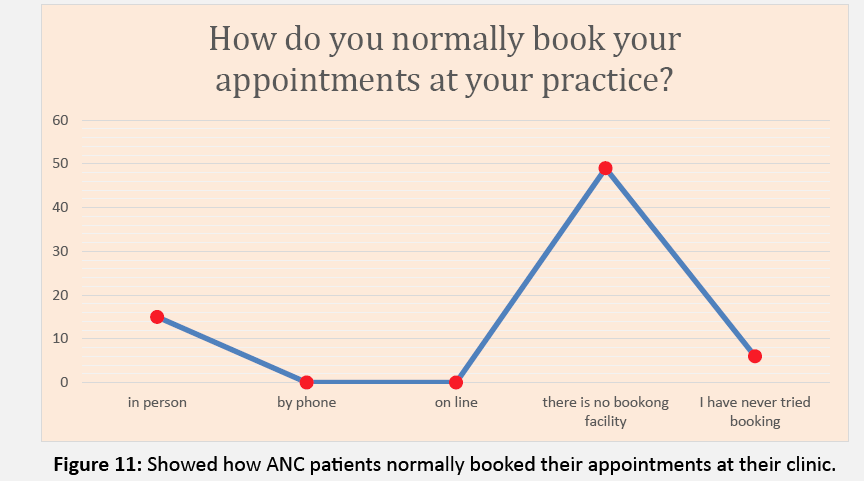
Figure 11: Showed how ANC patients normally booked their appointments at their clinic.
On how the respondents normally booked their appointments at their local clinic the following is what the respondents had to say; 70% of the respondents indicated that their local health facility did not have an advance booking facility, while 21.43% of the respondents in the ANC patient’s category indicated they normally booked their appointments in person. It is of note that up to 8.57% of the respondents indicated that they have never even tried making an advance booking at their local clinic.
Clearly the majority of respondents did not have a positive impression of the booking arrangement at their local health care facility as they said their local health Care facility did not have an advance booking facility. the above showed that staff at the local health facility told patients conflicting information because while they told 70% of ANC patients that there were no advance booking facility, they told a different story to 21.% of their ANC patients (Figure 12).
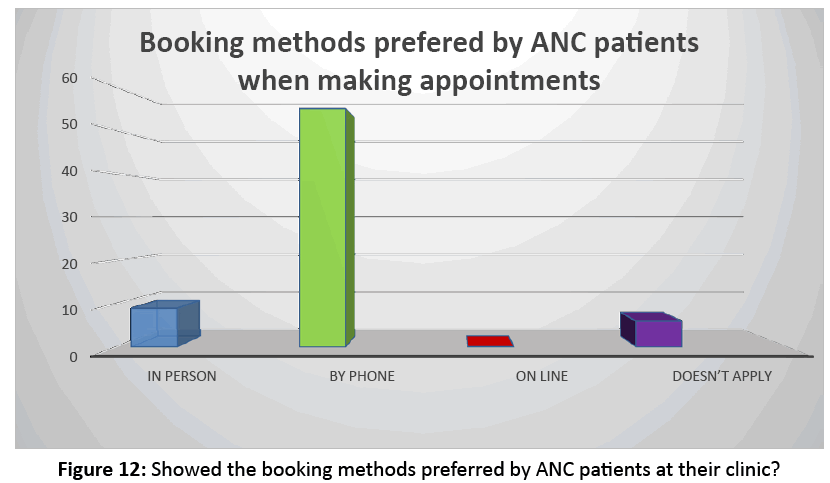
Figure 12: Showed the booking methods preferred by ANC patients at their clinic?
When asked which methods they preferred when booking advance bookings or appointments at their local ANC health care facility, 78.57% of respondents in the ANC patients category indicated that they would prefer to make their advance bookings or appointments through the phone, and the second highest figure (12.86%) of respondents in the ANC patients category indicated that they would prefer to book their appointments in person. Up to 8.57% of respondents thought that that question did not apply; most probably they had no preference as to the booking method. The above statistics therefore revealed that the majority of respondents preferred to make their appointments through the phone, this would obviously make it easy for them, since an advance booking makes it easier for the patient when they came they would then be attended as per their earlier booking (Figure 13).
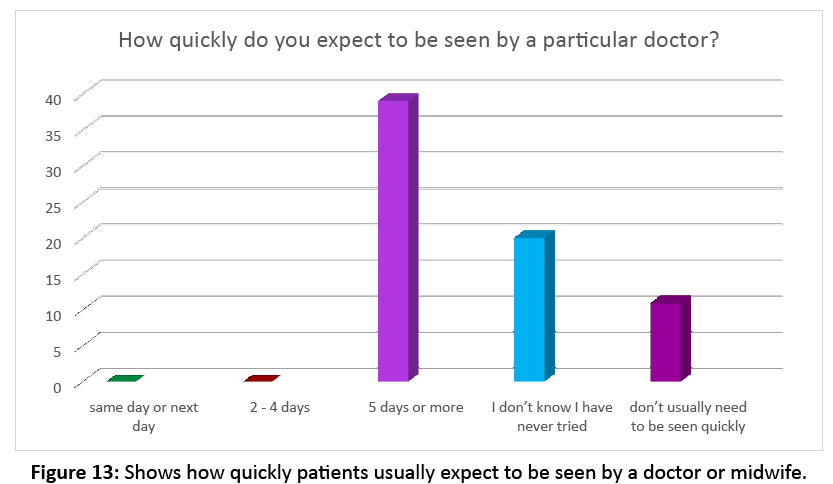
Figure 13: Shows how quickly patients usually expect to be seen by a doctor or midwife.
This variable was investigated in order to establish whether the ANC patients had the leeway to be seen by a Doctor or a Midwife of their choice, and if so how quickly they could expect to get seen by that particular doctor 55.71% of respondents in the ANC patients category indicated, when they wanted to see a particular doctor they usually expected to get seen in 5 days or more, this is compared to 28.57% of respondents who indicated that they had never even tried seeing a doctor or midwife of their choice. Finally 15.72% of respondents indicated that they do not usually need to be seen urgently by the doctor hence the issue of seeing a particular doctor did not apply to them. From the data above it can be clearly seen that for the majority of respondents when they expected to see a particular doctor, their standard waiting time 5 days or more. This then showed that the majority of respondents had lost faith in the system as their standard expectation period when they expected to see a doctor or midwife was 5 or more days (Figure 14).
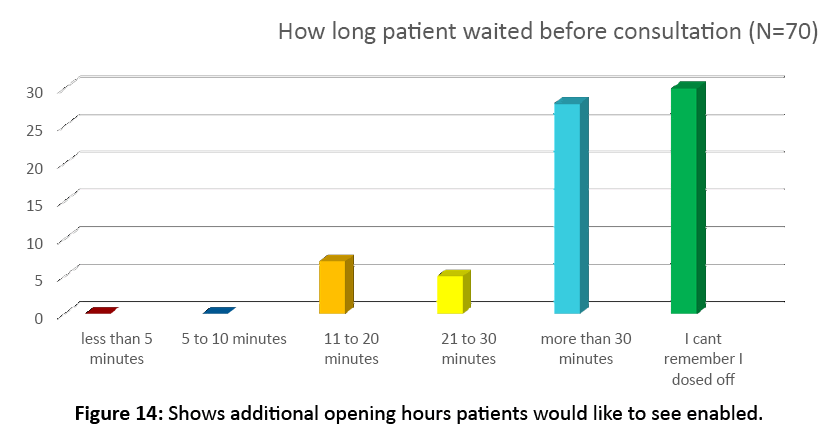
Figure 14: Shows additional opening hours patients would like to see enabled.
42.86% of the respondents within the ANC patients category indicated that opening after 6.30 pm would make it easier for the ANC patient to see or speak to someone at an ANC health care facility, 31.43% would prefer that their ANC health Care Facility to open over lunch and yet a third lot of respondents would prefer that their ANC Health Care facility be open on Saturday for them to be able to speak to someone. Clearly from the above observations it would tend to suggest that the majority of respondents would prefer that their ANC health care facility be open at either lunch hour or after 6.30 pm.
This Section C sought to present the respondents’ perception of service quality in comparison to their expectation on the service quality expectation and perception for ANC at Mberengwa hospitals and clinics. The perceived service quality is the consumer’s opinion of a product's (or a brand's) ability to fulfill his or her expectations. It may have little or nothing to do with the actual excellence of the product, and is based on the organization’s current public image (Figure 15).
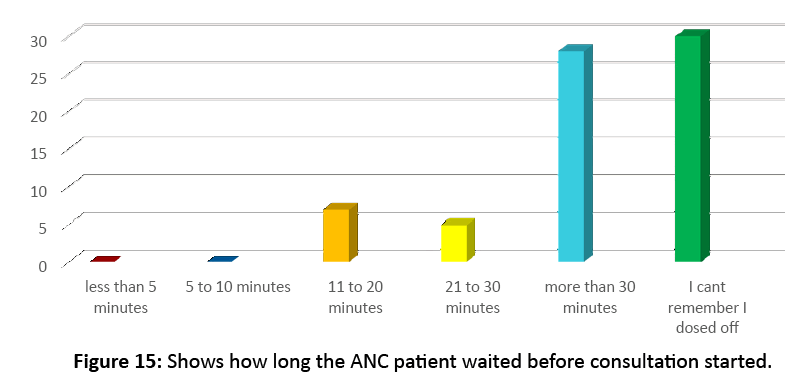
Figure 15: Shows how long the ANC patient waited before consultation started.
The study also took an interest in the amount of time it took the respondent ANC patient to wait before her consultation started; indeed this variable was thought to be important because in Ante Natal Care time is of the essence, it only takes a short time to make the distinction between a live birth/delivery or a still birth. Surprisingly up 42.85% of respondents indicated that they could not remember how much time they waited before their consultation started, according to the patient they dosed off before the consultation started, hence they could not remember the exact time they waited.
Up to 40% of respondents indicated that it took them more than 30 minutes for their consultation to start with their doctor up to 18.15% of respondents indicated that they waited for between 11 and 30 min before their consultation to start.
From the above data it was clear that for up to 42.85% the waiting time before their consultation was inappropriately long these respondents said the reasons they could not remember the amount of time they had to wait was because they had dosed. For a patient to dose off while waiting for her consultation to start means the waiting must have been really long, contributing to the poor service quality at Mberengwa District Hospital.
The results of the data presented in Figure 16 showed that the majority (64.29%) of the respondents rated the length of the time they waited as Very Poor, indeed with over 80% of respondents waiting for over 30 min before being attended to it would not come as a surprise that they were rating their waiting period as Very poor. Thirty percent of respondents rated their waiting period as Poor, meaning over 90% or respondents’ rating of their waiting period ranged from Poor to Very poor. Significantly none of the respondents rated their waiting period as satisfactory, good, very good or Excellent, which paints a very grim picture of the waiting periods at the health Care facilities in Mberengwa. The above data revealed that the majority of patients at Mberengwa district hospital rated their waiting time before consultation as Very Poor, which meant service delivery at Mberengwa District Hospital was poor, way bellow satisfactory levels (Figure 17).
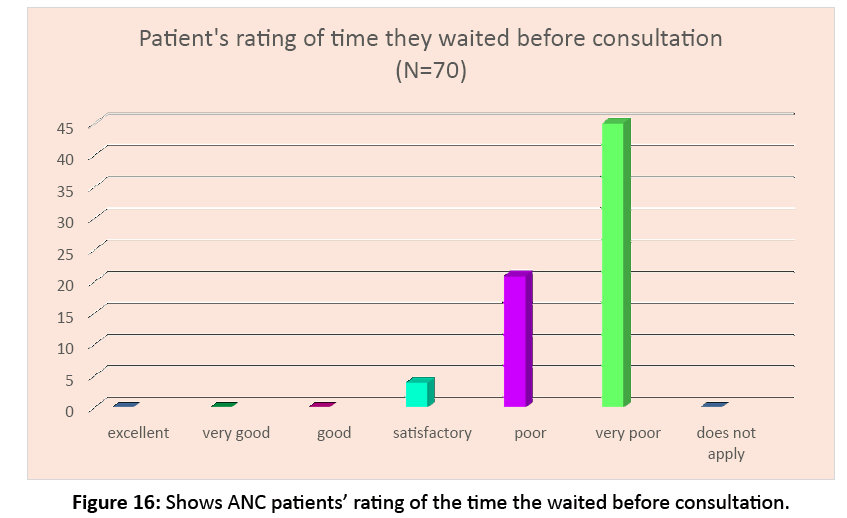
Figure 16: Shows ANC patients’ rating of the time the waited before consultation.
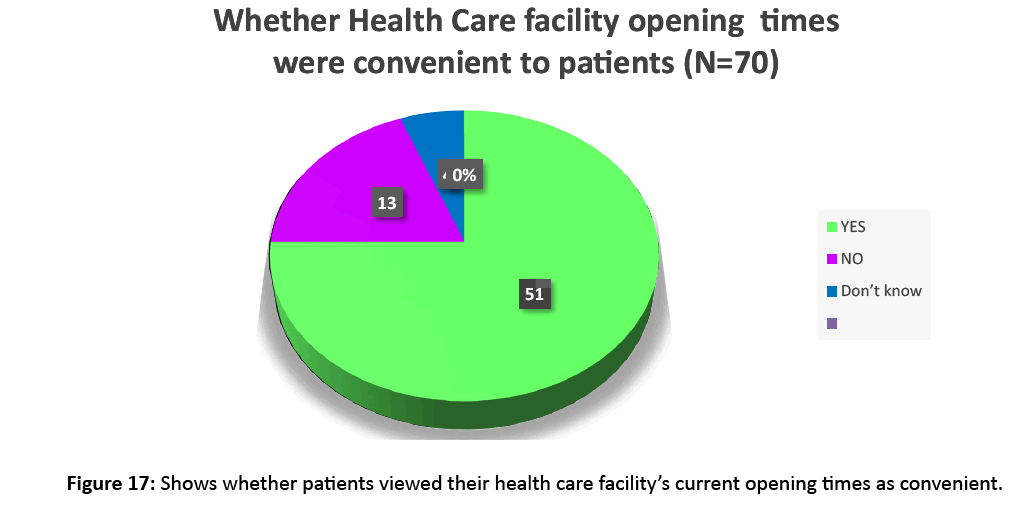
Figure 17: Shows whether patients viewed their health care facility’s current opening times as convenient.
The study took an interest in the Health Care facility’s opening times, in order to evaluate whether the current opening times were convenient to the ANC patients. Significantly up to 72.86% of ANC patients gave their Health Care facility thumbs up as they thought their current opening times were convenient to them. Only a paltry 18.57% thought the hospital’s current opening times were not convenient. The remainder, which is 8.57% of respondents refused to rate the current hospital openings times in terms of convenience. From the above data it can be deduced that the majority of patients were happy with the current opening times, which contributed towards the hospital’s positive service quality index (Figure 18).
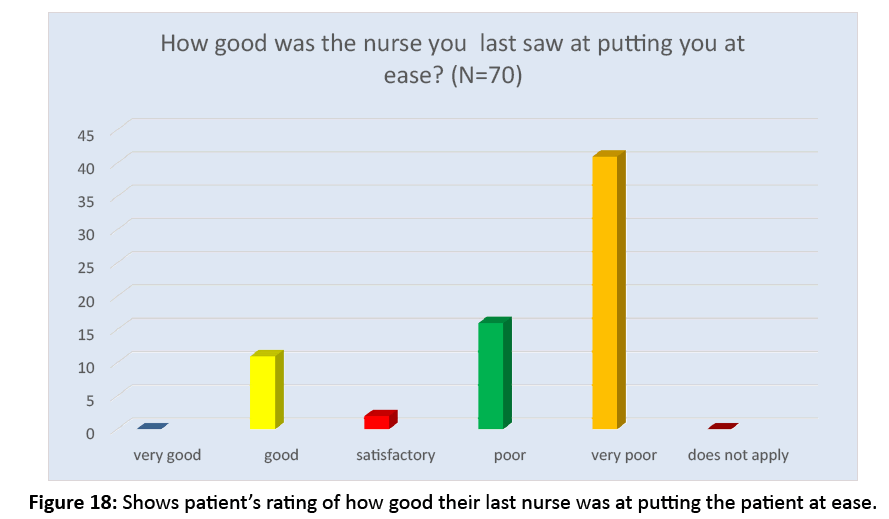
Figure 18: Shows patient’s rating of how good their last nurse was at putting the patient at ease.
The study set a keen interest on the patient’s rating of how good the Nurse was at putting her (the patient) at ease at the last visit. A significantly high percent of 58.57% indicated that they rated the last nurse’s skills at putting the patient at ease Very Poor. Notably only 15.71% of the respondents rated the nurse they last saw as good that is in terms of putting them at ease. A total of 18.57% ANC patients gave a rating of between satisfactory and very good while 81.43% gave a converse rating to the last Nurse they saw in terms of putting the patient at ease. Thus with over 80% of the ANC patients rating their last nurse between poor and very poor in terms of putting their patient at ease it is clear that in terms of putting the patient at ease the ANC patients’ perception was far below the patients’ expectations.
From the presented data therefore it was clear that the patient’s rating of their last nurse in terms of putting them at ease ranged between poor and very poor (Figure 19).
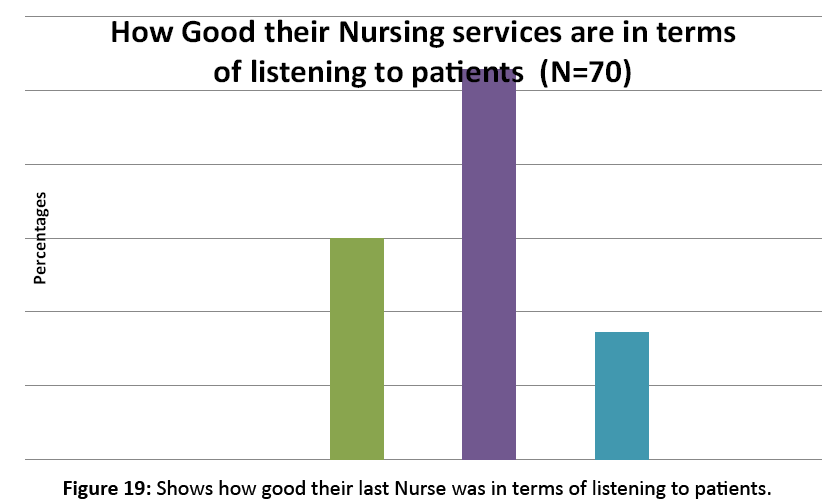
Figure 19: Shows how good their last Nurse was in terms of listening to patients.
According to scientist listening to patients is one very significant attribute which patients always look forward to noticing on a Health Care Provider, hence on the question of the patient rating the nurse they last saw in terms of how good the nurse was at listening to the patient, up to 52.86% of the respondents, gave the nurse a thumbs down by rating her/him as Poor, a further 17.14% rated their last nurse as Very Poor in terms of listening to patients. Notably, only 30% of the patients rated their last nurse positively in terms of listening to the patient, as they gave the nurse who last saw them satisfactory rating. Consequently, due to the fact that 70% of the patients rated their last nurse negatively, it therefore means that the Nurses at Mberengwa are poor at listening to patients which fact negatively impacts on the patients’ rating of the service quality at this Hospital (Figure 20).
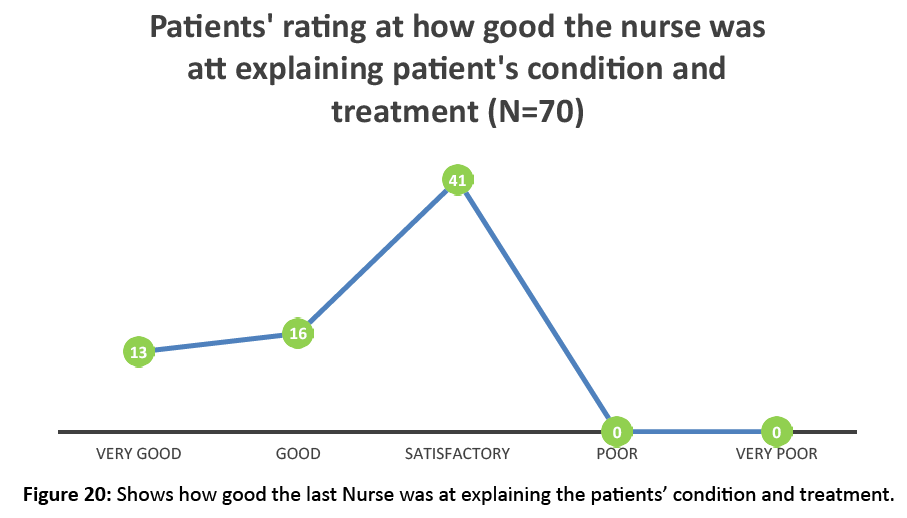
Figure 20: Shows how good the last Nurse was at explaining the patients’ condition and treatment.
According to WHO the Health Care provider’s capacity to explain the patient’s condition and treatment is a very important skill that any Health Care Provider should have if the Health Care Facility is to be viewed favourably by patients who receive health Care at such a facility. When the respondents were asked to rate how good their last Nurse was in terms of explaining the patient’s condition and treatment, their rating ranged from Satisfactory (58.57%), to Good (22.86%) and Very Good (18.57%).
Notably this is the only major score on which the ANC patients have rated the Nurses favourably with no single native marking. Thus the highest score which the ANC patients gave for the last Nurse’s ability to explain the patient’s condition and treatment was 58.57% who rated the Nurse as Satisfactory.
It therefore means in terms of explaining the patients’ condition and treatment Mberengwa District’s rating from its ANC patient is Satisfactory and favourable (Figure 21).
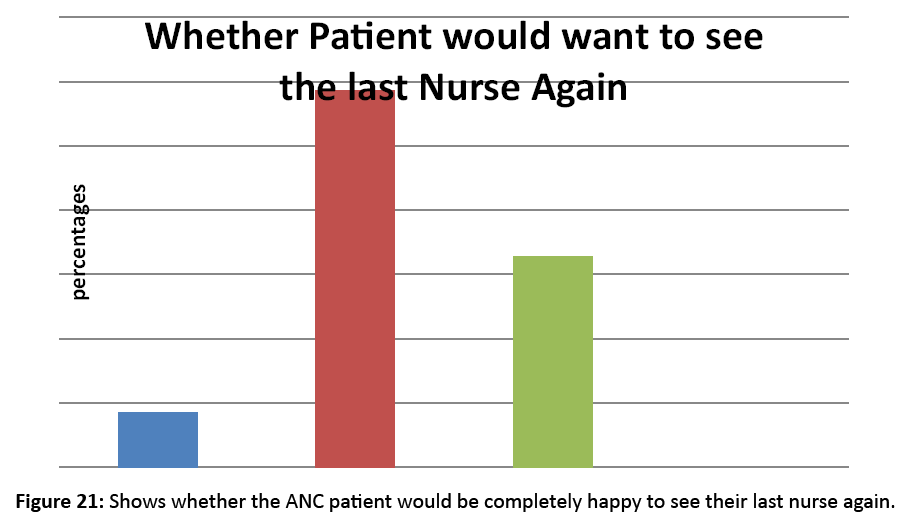
Figure 21: Shows whether the ANC patient would be completely happy to see their last nurse again.
The study took an interest in how the patient would respond to the question of whether they would want to see their last Nurse again, Only 8.57% gave a definitely yes response, however 58.57% gave a conditional affirmative answer as they said they would only want to see their last Nurse “ if there was no alternative. However a sizable figure of 32.86% had a very negative rating of the last nurse at they said they would definitely not want to see that nurse again.
Thus with only 8.57% of the respondents giving their last Nurse a positive vote on whether they would want to see him/ her and 58.57% giving a conditional affirmative response it then means that Mberengwa District would not survive in an era of competition as the majority of their patients would only return “if there was no alternative.”
Which Gaps Exist Between Patients Expectations and Patient Perception
This section sought to establish the expectation Gap between the customer’s expectations and customer’s perceptions, the extended Ps, the physical condition, people and processes.
When somebody is not well, speaking to a Health Care Worker can make the difference between getting better or getting worse. The research took an interest in how often the patient speaks to the Nurse or GP she prefers, when attending Ante Natal An analysis of Figure 22 above revealed 82.86% of the respondents in the ANC patients category indicated that they have never or Almost Never spoken to GP or Midwife or Nurse of their choice.
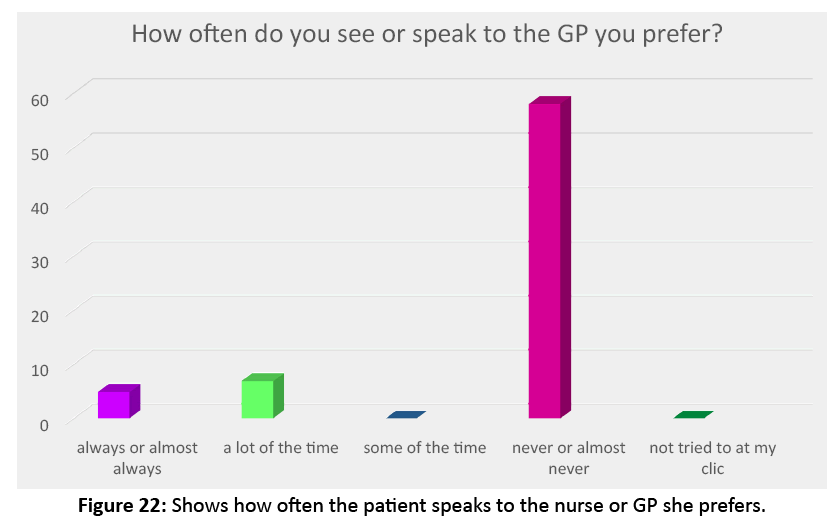
Figure 22: Shows how often the patient speaks to the nurse or GP she prefers.
Only 7.14% of respondents indicated that they had Always or almost always spoken to the GP or Nurse of their choice, 10% of the patient indicated they spoke to a GP or Nurse of their choice a lot of the time.
Thus with 82.86% of the respondents having never spoken to a GP of their choice, it is clear that the issue of patient speaking to the GP or Nurse of their choice is not given priority at Mberengwa District Hospital, thus negatively impacting on the quality of service deliver to patients (Figure 23).
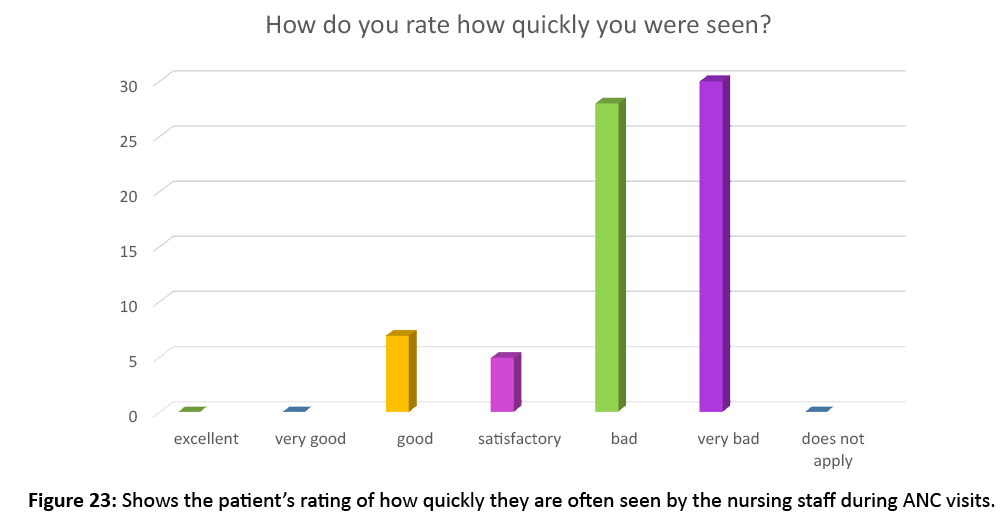
Figure 23: Shows the patient’s rating of how quickly they are often seen by the nursing staff during ANC visits.
This variable was investigated in order to establish the Expectation Gap between Customers’ expectations and customer perceptions in service quality delivery as it was felt necessary to have just a snap-shop of what the patient’s experiences were at the hospital or clinic. An analysis of the statistics above revealed that the views of 72.85% of ANC patients revealed their views ranged from Bad to Very Bad. This is contrary to the views of up to 17.15% of the respondents who rated the speed at which they were served at between good and satisfactory.
From the above data it was clear that the majority of respondents were not pleased with the speed at which they were often served at Mberengwa District Hospital, meaning that the waiting at the Hospital is unbearably long (Figure 24).
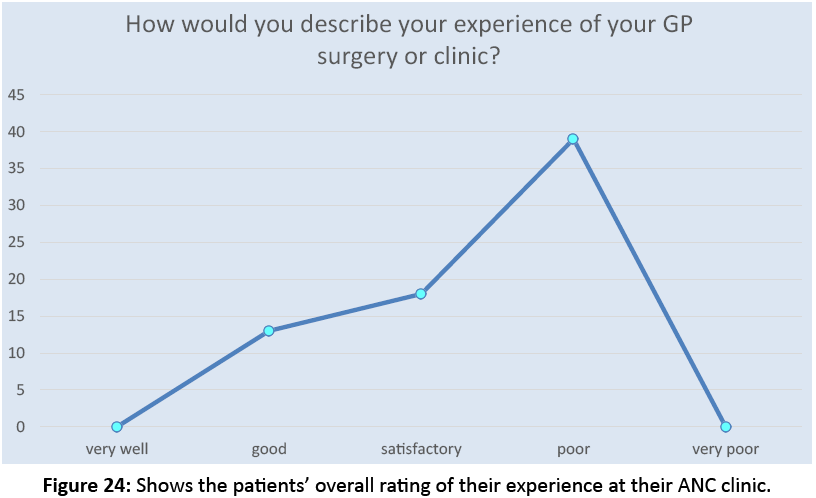
Figure 24: Shows the patients’ overall rating of their experience at their ANC clinic.
Pregnancy is a time when expectant mothers feelings are very delicate, thus it was thought it would be proper to get the patient’s overall rating of their experience at their ANC Clinic. An analysis of the ANC patients’ overall rating of their experience at their ANC Clinic showed that 55.71% rated their experience as Poor, however 25.71 rated their overall experience at their ANC Clinic as Satisfactory, while another 18.57% rated their overall experience as Good.
Indeed with the majority of ANC patients rating their overall experience as Poor it was clear that overall experience of Ante Natal Care patients is unfavourable, thereby negatively impacting on the level of satisfaction of ANC patients.
This variable was thought to be important as it rated the ANC’s overall experiences with all staff at Mberengwa District Hospital, the difference between this question and a previous similar question was in the sense that the previous one only asked about the patient’s experience with their last health care provider. It should be noted therefore that unlike the previous question this one would give a holistic view of the whole institution’s service delivery. Figure 25 above shows that the patients’ overall rating of the way the doctor or nurse explained their condition and treatment is Poor, this as conformed by 70% of ANC patients although the remainder gave the hospital an overall rating of Satisfactory. Overall therefore the rating given to Mberengwa is poor meaning the perception of service does not exist at Mberengwa District Hospital
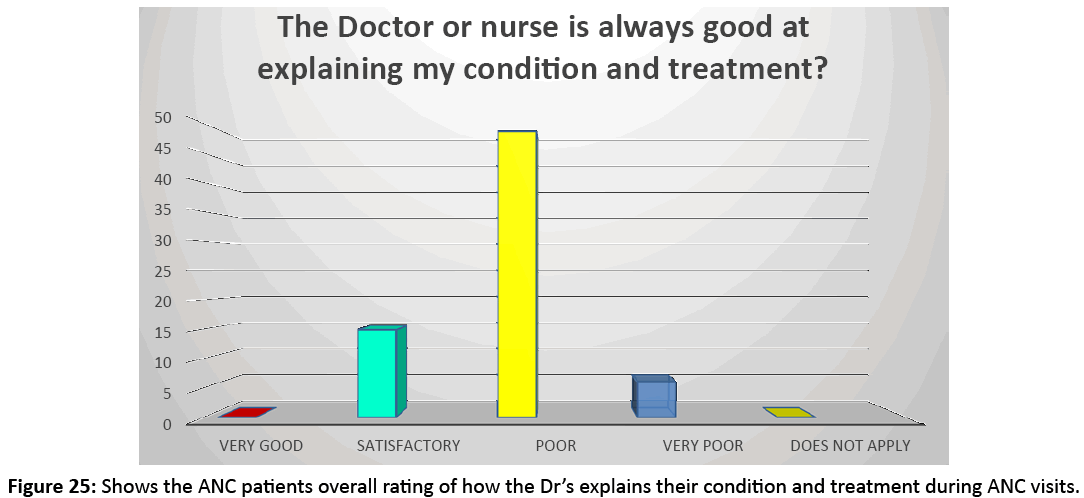
Figure 25: Shows the ANC patients overall rating of how the Dr’s explains their condition and treatment during ANC visits.
An analysis of Figure 26 above showed that patient’s rating level of treatment provided by the Mberengwa District Hospital were ranging between Satisfactory and Good, 78.57% of respondents indicated that they rated the treatment provided by the Health Care Provider as Satisfactory, while the remainder (21.43%) rated the treatment level as good.
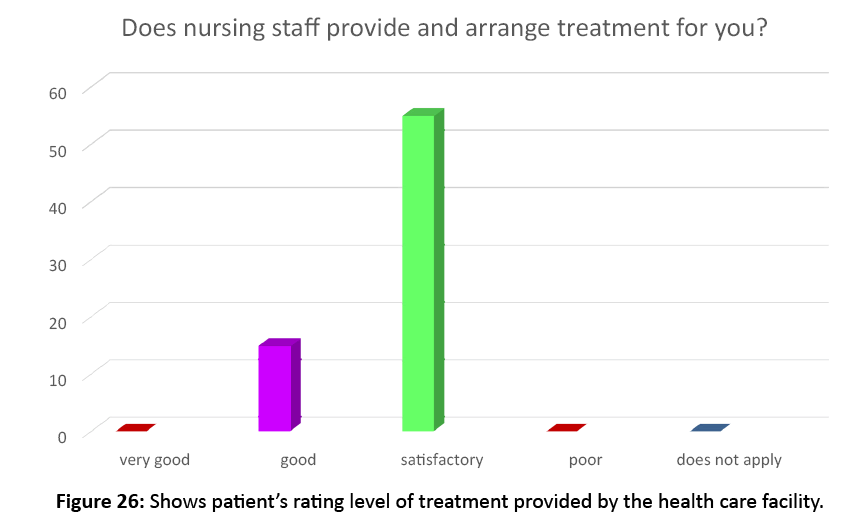
Figure 26: Shows patient’s rating level of treatment provided by the health care facility.
Hence with a patient rating of treatment level ranging from Good to Satisfactory it became obvious that the majority had a fairly favourable impression of the level of care provided by Mberengwa District Hospital. Thus that showed clearly that the level of health care service delivery at Mberengwa was reasonable.
Figure 27 above shows whether every time the patient receives treatment they have confidence that the nurse is honest and trustworthy, 78.57% of respondents indicated that every time they received treatment they had confidence that the Nurse was honest and trustworthy. 21.43% were still sceptical about the level of honesty and trustworthiness still being displayed at the Health Care Facility.
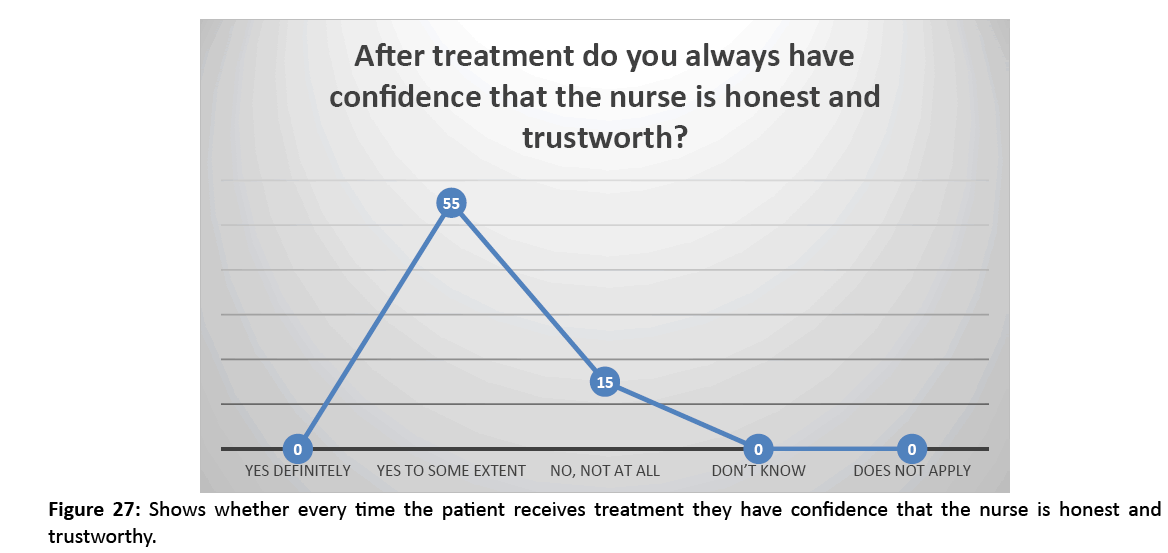
Figure 27: Shows whether every time the patient receives treatment they have confidence that the nurse is honest and trustworthy.
From the above it has become apparent that the majority of ANC patients at Mberengwa District hospital had lost all faith of honesty about the hospitals’ integrity (Figure 28).
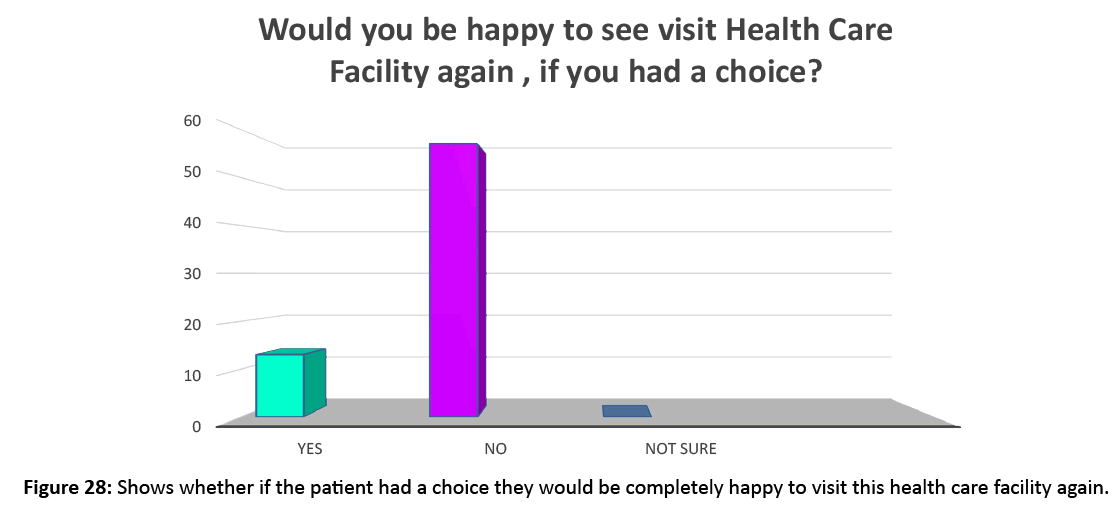
Figure 28: Shows whether if the patient had a choice they would be completely happy to visit this health care facility again.
On the question of whether if the ANC patient had a choice they would be completely happy to visit this Health Care Facility again, an analysis of the responses revealed the following, 81.43% categorically said No, they would not want to visit this Health Care Facility again, while the remainder 18.57% gave it a yes vote by saying they would want to visit the Health Care Facility again. None on the respondents it appeared the goings on at the hospital left one either voting for it or voting against it. Given the above result it is clear that something needs to be done urgently at this Health Care Facility.
This is the ultimate measurement of customer satisfaction when a customer gets to be an advocate who refers the organization to his friends; this variable was thought to be necessary as it would show that the patient had faith in the operations of a Health Care Facility. An analysis of Figure 29 above revealed that 67.14% of respondents said they would definitely not refer Mberengwa District Hospital to someone who had just moved to their neighbourhood; conversely 18.57% affirmed they would definitely refer a new neighbour to their Health Care Provider.
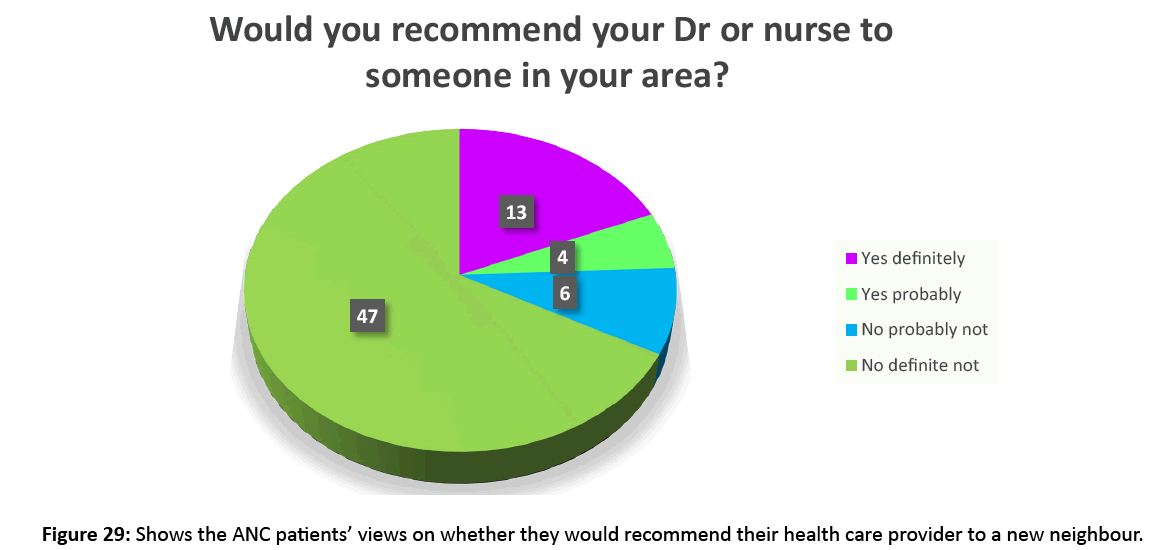
Figure 29: Shows the ANC patients’ views on whether they would recommend their health care provider to a new neighbour.
However 8.57% said they would probably not, bringing the total number of negative votes to 75.71% of respondents who would not recommend their local ANC clinic to a new neighbour. This there means the service quality at Mberengwa District hospital has sunk so low even those who use it often would not want to refer new patients to this Health Care provider [37].
Understanding customer expectations in health care delivery
The study revealed that Ante Natal Patients had high expectation from the minute they walk into a Rural Delivery Centre, customer expected courteous service from the receptionist. Even when they tried to make bookings to see the doctor or Senior ANC nurse ANC patients expected to get through on the phone easily and book and appointment. When ANC expected to see a particular doctor or Senior quickly they expected an easy passage to the Health Care service provider. During an emergency particularly, if they wished to see a particular doctor or senior nurse they did not expect any hassles.
Indeed before the consultation they expected to be able to speak to a doctor or senior nurse of their about any medical condition that they had.
Understanding customer perceptions in health care delivery
From data gathered it was apparent that in the majority of cases it was apparent that their expectations soon turn into a shock as they perceive the reality on the ground, in the majority of cases it took an average ANC patient no less much more than two hours to see a doctor or senior for consultation.
On being asked to rate the amount of time they waited the majority of ANC patients indicated that they rated the amount of time they waited as very poor.
In as far as the health facility’s opening time were concerned ANC patients generally perceived the Health Care Facility’s opening times as falling a bit off the normal one they would prefer. While the Health Care Facility had “normal “8 to 4” working hours ANC patients who would be doing their daily chores during those “normal” hours expected operating hours that stretched well beyond 1830 h.
investigating whether there is a gap between customer expectations and customer perceptions in health care delivery
According to the data gathered the gap between ANC patient expectations and ANC patient perceptions was visible in almost all facets of Health Care Service Delivery.
Right from the time the patients tried to make a booking to see the doctor or senior nurse, one the expectations side they expected to be able even to speak to the doctor or senior nurse, but alas they were told they could not speak to the doctor or nurse over the phone.
When the ANC were expecting to make bookings as to the time they could see the doctor or senior nurse most Health Care told the ANC patients in no uncertain terms that they did not have a booking facility where one could book and see the doctor of senior at a particular time.
ANC patients had earlier thinking about the care they got from their doctors and nurses overall, to be able to assist one to understand their health problems. Data gathered revealed the Doctor or Senior Nurse’s process of patient Care would fall short or what patients expected.
Indeed the gap between the ANC patient expectations and ANC patient perceptions was apparent throughout the Health
Service Delivery profile, from the booking for appointments, the reception a patient got,
Understanding customer expectations in health care delivery
It was recommended that the educated about the existence of the Patient Chapter, which exists in the Zimbabwean Health delivery system.
As the patient is the centre of all activities that occur at the hospital, she or he must be fully educated on the full extent of their expectations at a Health Care Facility. Indeed knowing what the privileges and their right will empower the patient to the extent of knowing when the rights were being violated and when service delivery is falling short.
Understanding customer perceptions in health care delivery
Given the gap that is there between ANC patient expectations and perceptions, it is recommended that the Health care facilities introduce a system where patients can manage to book appointments in advance.
Patients were spending a lot of time queuing before seeing the Health Worker, given the shorter working hours and the long queues that were there at the hospitals, it is recommended that Health Care introduce longer operating hours so as to accommodate patients who would prefer “after normal hour visits”
Secondly given the complaints that respondents raised about the poor reception that is accorded to incoming clients, it is recommended that Nurses who man the reception area undergo some training in Customer care.
The booking time issue can be managed together with the opening hour’s issue, once one is solved it will help decongest the Health Care facilities.
The Doctor or Senior Nurse was accused of not listening to the customer in coming up with a decision, this could be due to the workload that these professionals are subjected it is recommended that staffing levels be increased so that the professionals on duty are not overwhelmed by the volume of work.
ANC patients were vowing that if they had a choice they would not these Health Care facilities again, this is a very unhealthy situation it is recommended that local management at these Health care take not of the findings of this report and work hard to address it.
Based on the findings of this research the following suggestions for future research were made: this study was conducted at one District based in the Midlands Province. From future research it is recommended that a similar investigation involving a larger study area possible the whole province be undertaken using a hybrid approach i.e. qualitative as well as quantitative research methods. Alternatively, a comparative approach of a case study could also be conducted with a limited sample in a different Province using two different crops say maize and sorghum in a different district setting so that the result could be established.